#which is why two of its modes help trigger paradox
Explore tagged Tumblr posts
Text
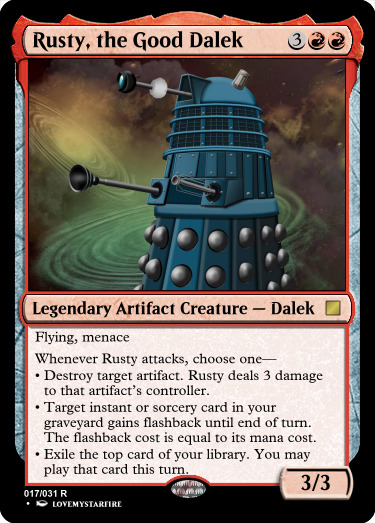
Art by lovemystarfire
Card transcription
Rusty, the Good Dalek 3RR Legendary Artifact Creature- Dalek [rare] Flying, menace Whenever Rusty attacks, choose one- * Destroy target artifact. Rusty deals 3 damage to that artifact's controller. * Target instant or sorcery card in your graveyard gains flashback until end of turn. The flashback cost is equal to its mana cost. * Exile the top card of your library. You may play that card this turn. 3/3
End transcription
#original post#mtg#custom magic card#universes beyond#doctor who#this is meant for temur paradox deck#which is why two of its modes help trigger paradox#the flashback is also meant as a flavor thing#since the doctor showing it the memory of the star being born helped turn it goodish again#and then the first mode is of course a parallel to how the exterminate card works#but with creature replaced with artifact since rusty kills other daleks#and it's a 3/3 with menace since that's what other daleks are
6 notes
·
View notes
Text
Dabi’s Missing Heart
So I’ve been seeing two main responses to Dabi’s character as portrayed in BNHA 292, both of which I feel touch on a very surface understanding of his character and role in the story despite seeming like opposite takes.
Take #1:
Dabi is an unfeeling monster created to show the redeemability of Shigaraki and Enji in contrast with his true eeeevil villainy! He will never be redeemed!
Take #2:
Dabi is a sweet softy who did nothing wrong! He will never be redeemed because of this chapter which is so out-of-character!
Note how they both have the same endpoint. I’m not actually gonna address the redemption question much because I can’t fathom what this panel foreshadows if not Touya’s salvation (alive):
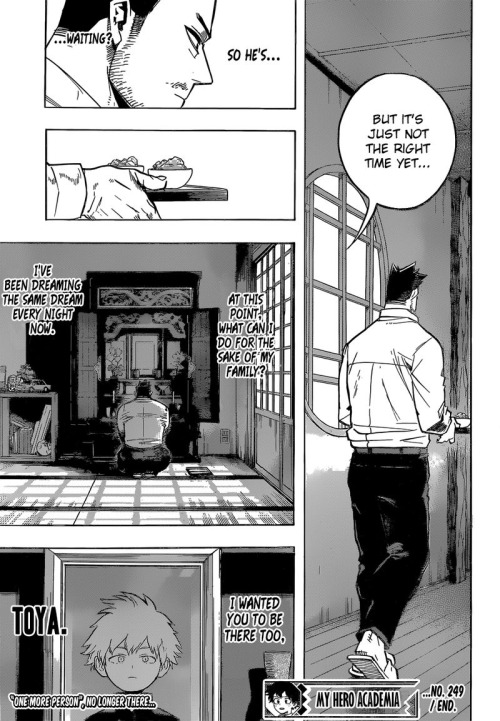
I’m not looking to debate this either; I’m just putting it here because I know it’ll come up if I don’t.
Instead, I wanna address Dabi’s character. He’s my favorite, and I’ve been asked a few different times whether I enjoy him as a villain or as an uwu poor baby, and my answer is always both.
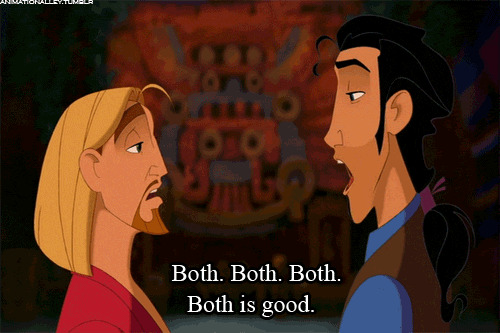
Dabi is a villain. This chapter’s rampage is, in my opinion, not remotely out of character for him. But neither is it the summation of his character, and he surely is not meant to make Enji look good by comparison.
So, who is Dabi?
Dabi is kind of a flaming jerk, and that’s why I like him. He’s an abuse victim who gets to be angry and crass and sharp. He pushes people away because he doesn’t want to open up to them and get burned (heh). He’s just like Shouto in that, except with a dose of murder.
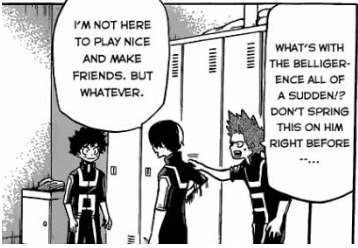
Believe it or not, this is a very realistic response to abuse, and very common too. It’s good to see that representation. If the writing was indeed just “he’s bad get rid of him,” well, that would of course be a terrible representation. But seeing a mean victim get redeemed? Now that’s some good sh*t I’m here for.
If you want a sweethearted, misunderstood soft victim, there is one in MHA, and that’s Shigaraki. Dabi is not these things, but that does not mean he’s not a victim or that he’s somehow an unfeeling monster.
You see, Shigaraki is a heart character. Dabi’s the mind. (Heart and mind characters are a literary pattern that is utilized in literature across the globe; it’s not an eastern/western cultural thing. It has its roots in alchemy.) The problem is that you can’t have a heart without a mind nor a mind without a heart. If you lack one, you’re missing half the picture, and you won’t accomplish anything.
We see this with Shigaraki in his quest to look for ideals, something to believe in, purpose to justify/enable acting on his feelings/emotions.


Dabi, in contrast, has conviction and ideals, but eschews any kind of personal connection and care.

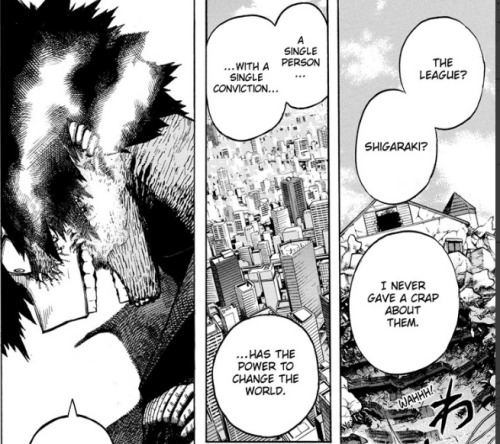
So, both Shigaraki and Dabi struggle to unite heart and mind--but they need to do precisely this.
It’s not a coincidence that Shigaraki expressly envisions both Dabi and Himiko when musing on what his purpose is.
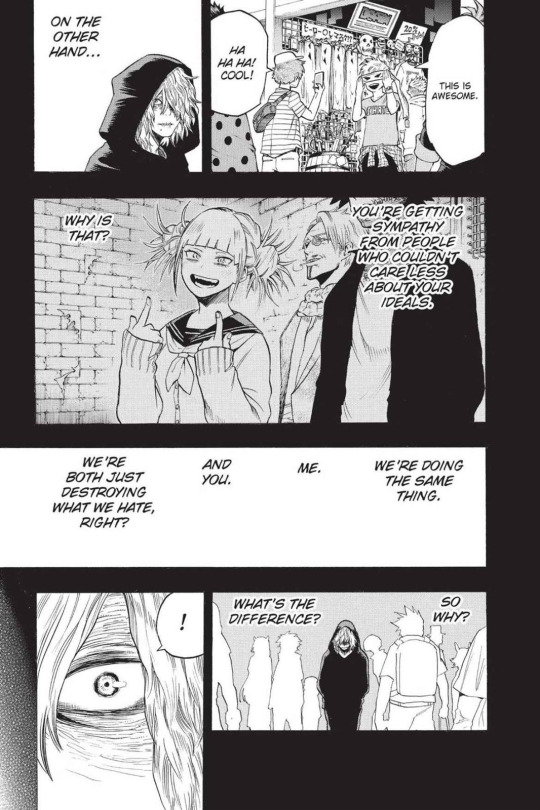
Yet Shigaraki is able to unite more easily with Himiko as opposed to Dabi because Himiko is also a heart character. She claims to be motivated by extreme empathy that warps around to become a lack thereof (wanting to be who she loves).
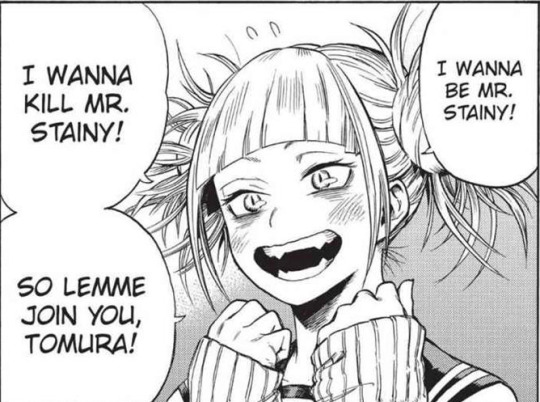
Shigaraki’s motivations are basically revenge for hero society not saving him--which encompasses both a deep internal and external (societal) need for empathy and a need for better ideals. Shigaraki needs Himiko and Dabi. They’re a trio, and all of them need each other to grow. But Himiko, being similarly driven expressly by emotions, is easier for Shigaraki to understand and work with.
The irony is that Dabi is actually a very, very emotional character as well. But what he does (as is typical for a mind character) is repress them, compartmentalize, dissociate. He constantly pushes people away, yet admits privately, to himself, that he’s primarily (and paradoxically) motivated by family. This is emotional, yet Dabi claims he “overthought” and, according to other translations, “snapped” can be actually be read as “went crazy” as a result over overthinking (note: both are mind allusions).

Dabi repressing who he is--Todoroki Touya--is symbolic of him repressing his emotional side, because again, family and emotions are tied together for his character. Now his identity is acknowledged, and Dabi claims to be losing his mind (again), claims that he can’t feel, and yet is completely consumed by emotions. Like, does anyone think he’s being methodical and calculating this chapter?
It’s not just negative emotions (rage, hate) that drive Dabi in response to his family. His seeking belonging and emotional connection is present even in a chapter where he tries to murder two members of his family and laughs off the risk to the life of another.
See, Dabi first asked Shouto to validate his pain:

But like, given the circumstances, of course Shouto doesn’t really respond well. How Shouto responds is this:

Shouto’s words are triggering. And keep in mind I am not blaming Shouto: he’s in shock and he’s a kid. I’m merely trying to explain how it likely comes across to Dabi.
You’re crazy. Your feelings don’t matter. You don’t really care about Natsuo! You’re a villain and that’s ALL you are. Not a brother or abuse survivor. Just a villain.
So, uh, yeah, Dabi then retreats back to being unable to feel, dissociating as has always been his coping mechanism. But that’s not all: Dabi’s been repressing for so long that of course he’s gonna go a little insane in response to the dismissal of everything he’s trying to point out. Why wouldn’t he? His family dismissed his pain back then and now again, and so, without that heart, without those emotions, principle is all Dabi has. This has been present since long before Stain’s ideology came into his life:

Now, he answers this question of existence through Stain’s ideology. Purpose is all he has, and to him, Shouto and Best Jeanist are dismissing that too. Why are they dismissing it? Best Jeanist dismisses him for an ideal: the overall good of hero society. Shouto has a mixture of this ideal and also like, genuine shock and pain.
Back to Dabi. Dabi’s summation of himself and his purpose is incorrect and harmful to himself and others. I’m not excusing him or justifying, just explaining. It’s a tragic reflection of what Endeavor raised both Touya and Shouto to be (and thereby ironic that BJ uses an ideal to dismiss him):
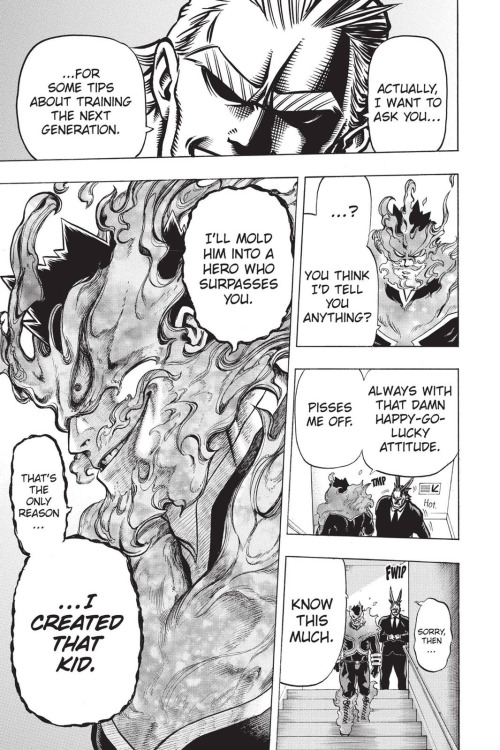
Instead of being raised to be the symbol of hero society--as Endeavor intended--he exists to destroy it. The root is the same: Dabi assumes he exists for hero society, as a tool. He dehumanizes himself, hence why his quirk physically harms him (which also fits his almost religious zeal for Stain’s ideology). But it is not all Dabi is. He’s not a tool, he’s a person, but to acknowledge he’s a person involves acknowledging his heart/emotional desires, and that gets to my next point.
Dabi’s not a reliable narrator about himself. At all. I’ve written about Dabi and dissociation before. So let’s look at Dabi’s devotion to his ideals, the ideals he puts above people and claims he only cares about... because there are moments where Dabi goes against those ideals.
For one example, Dabi’s gone against those ideals when he’s allowed his personal need for revenge (an emotional/heart motivation) to overcome his longterm plan. Like, he was fully about to get himself killed here, even though that would likely mean no one would know the corruption of the Todoroki family and hero society, just for the chance to prove to his father that he hurt him.
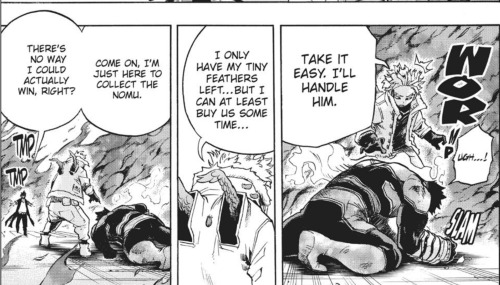

In addition, I’ve talked before about how Dabi’s the only character in the entire damn manga to comment that maybe using child soldiers is not okay. While it’s not explicitly stated, it’s reasonable to conclude that Dabi considers the abuse of children in hero training a sin of hero society that ought to be purged (hence, part of his ideals).
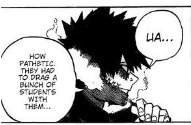
That said, I have also pointed out that Dabi has gone after children in the past when it benefits his mission (Bakugou would like a word). So let’s look at four examples of Dabi and his principles concerning kids--since, after all, he claims to be motivated by heroes who hurt kids.
Firstly, Dabi’s “save the cat” when he spared Aoyama.

Why did he spare Aoyama? We can only speculate, but it seems quite likely there are two reasons: 1) hurting Aoyama would not add anything to his overall goal of downing hero society, and 2) a terrified, cowering kid might just have been a teeny bit familiar to Dabi. Here, his ideals--destroying hero society--either take a backseat to a reflection of his personal pain (and)/or his ideal of not abusing kids directly contradicted his ideal of bringing down hero society. But the important part is that in this instance, Dabi chose mercy and the goal of bringing down hero society was jeopardized as a result.
So then why did he attack Tokoyami, Nejire, and Shouto this arc? Well, Dabi does things he knows are wrong for the sake of accomplishing his overall purpose. He does things he knows hurt himself for this purpose. This isn’t new. If he can’t be acknowledged, can’t exist as a person with emotions, then he at least will ensure he still has a purpose.

In addition, let’s look at what sets Dabi off in all of these instances. (Again, this isn’t me saying “well actually Dabi’s justified.” He’s not. I’m just pointing to what’s in the text to explain the machinations beyond “bad guy do bad.”)
Dabi tries to reason with Tokoyami, pointing out that Twice was doing essentially what Tokoyami is doing: trying to save his friend(s), but Tokoyami doesn’t listen (also again: not me saying Tokoyami should have listened--realistically, in this situation, it makes sense Tokoyami trusted his mentor!)


Only after his reasoning was rejected did Dabi go to flames mode. He could have just let Tokoyami save Hawks, but instead he really wanted to kill Hawks and that overrode his other principles. Was this just because of his furthering his goal--killing the #2 hero would help destroy hero society--or because of a sense of personal revenge for Twice? That’s open for interpretation (in my opinion, it’s likely a mixture, because again, it tends to intertwine more than Dabi likes to think it does). His principles and/or emotions are brushed aside, and Dabi Does Not Like That.
Dabi does this again with Shouto this chapter, asking him where he stands on their family issues, and gets brushed aside, and then Shouto goes into his rage mode and Dabi responds. Again, not saying Shouto is rational here or that he should side with Dabi’s murderous plan, but like, his words really don’t come across well to Dabi.


Dabi going after Shouto after explaining things, asking Shouto for help, and then having his pain dismissed is pretty much a repeat of Tokoyami. When Dabi’s pain is dismissed, he says fine, let’s aim for the highest principle possible: making Stain’s will a reality, and damn any emotional ties.
Dabi’s obsession with ideals, you might say, is a smokescreen to cover his own pain. Far from feeling nothing, he feels very deeply. (I promise I’m getting to Nejire.)
So what does this indicate? Well, that Dabi does have a heart and a conscience. But when he lets his heart act, when his heart reaches out, he gets burned. His heart jeopardizes his overall purpose, so he most often dissociates himself from it. But by pretending he doesn’t have a heart, he dehumanizes himself, and he projects that dehumanization onto others (see: seeing Shouto as an extension of Endeavor, when that’s actually the precise image Shouto is trying to shed).
It’s not a coincidence that Shigaraki has been unconscious during the entire confrontation with Endeavor, nor is it a coincidence that Himiko has been MIA. But, Shigaraki wakes up a bit this chapter not only when hearing Dabi spout about how hero society needs to burn, an ideal/the thing Shigaraki lacks, and through a less important but still-ideal-driven character in Spinner asking him to accomplish his supposed ideal of destruction, but when Dabi saves Shigaraki and Spinner.
Dabi doesn’t burn Nejire for lols (not that this makes it better because it doesn’t) or even for ideals. He burns her to save Shigaraki and Spinner, because they are his links to full humanity right now.

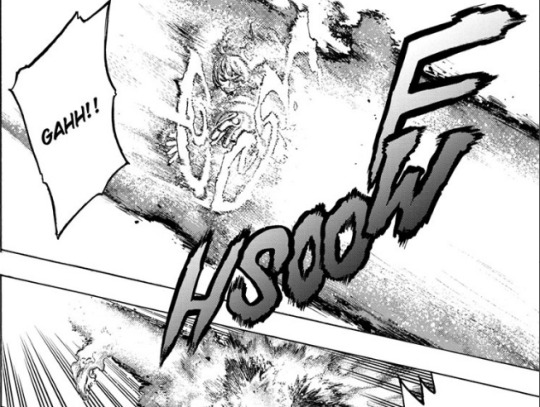

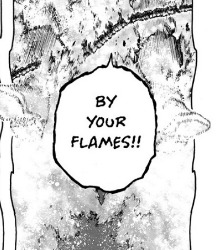
(Again, this is also dissociation and projection: Endeavor did this! No, Dabi, you did. You’re perpetuating violence against kids rather than stopping it.)
But anyways, when Dabi calls upon heart, Shigaraki wakes. He lends Gigantomachia and thereby Dabi and the league power.

Dabi can only grow and actually accomplish anything related to his ideals (fixing hero society) through accepting a heart--even though that will likely mean some painful surgery to shift his ideals to accommodate said heart, because pure ideals don’t leave much room for humanity. He needs to feel to actually change anything, because right now he’s just making things worse (hence, the need for saving and redemption).
I know the League aren’t the protagonists of the serIes, but their complaints aren’t exactly incorrect either (if anything they’re almost a little too valid). But through growing together, Dabi, Shigaraki, and Himiko might actually be able to accomplish something, and get themselves in a place where they can be reached and saved by Shouto, Deku, and Ochaco. Because to be saved, the kids will have to acknowledge the villains’ pain and complaints, and do something about it.
#bnha 292#bnha meta#mha 292#mha meta#dabi#todoroki shouto#todoroki touya#todoroki enji#hado nejire#toga himiko#shigaraki tomura#shimura tenko#best jeanist#boku no hero academia#my hero academia#bnha theory#mha theory#league of villains#spinner
1K notes
·
View notes
Text
Alain de Botton on Existential Maturity and What Emotional Intelligence Really Means
“The emotionally intelligent person knows that they will only ever be mentally healthy in a few areas and at certain moments, but is committed to fathoming their inadequacies and warning others of them in good time, with apology and charm.”
“Maturity is the ability to live fully and equally in multiple contexts,” poet and philosopher David Whyte wrote in one of his most beautiful meditations. A generation before him, Anaïs Nin took up the subject in her diary, which is itself a work of philosophy: “If you intensify and complete your subjective emotions, visions, you see their relation to others’ emotions. It is not a question of choosing between them, one at the cost of another, but a matter of completion, of inclusion, an encompassing, unifying, and integrating which makes maturity.” And yet emotional maturity is not something that happens unto us as a passive function of time. It is, as Toni Morrison well knew, “a difficult beauty, an intensely hard won glory” — the product of intentional character-sculpting, the slow and systematic chiseling away of our childish impulses for tantrums, for sulking, for instant self-gratification without regard for others, for weaponising our feelings of shame, frustration, and loneliness. Like happiness — another life-skill we have miscategorised as a passive abstraction — it requires early education, consistent relearning, and unrelenting practice.
That is what Alain de Botton, one of our era’s most uncommonly perceptive, lyrical, and lucid existential contemplatives, offers in The School of Life: An Emotional Education (public library) — the book companion to his wonderful global academy for self-refinement, a decade in the making.
De Botton considers the type of learning with which the road to emotional maturity is paved:
“The knack of our species lies in our capacity to transmit our accumulated knowledge down the generations. The slowest among us can, in a few hours, pick up ideas that it took a few rare geniuses a lifetime to acquire.
Yet what is distinctive is just how selective we are about the topics we deem it possible to educate ourselves in. Our energies are overwhelmingly directed toward material, scientific, and technical subjects and away from psychological and emotional ones. Much anxiety surrounds the question of how good the next generation will be at math; very little around their abilities at marriage or kindness. We devote inordinate hours to learning about tectonic plates and cloud formations, and relatively few fathoming shame and rage.
The assumption is that emotional insight might be either unnecessary or in essence unteachable, lying beyond reason or method, an unreproducible phenomenon best abandoned to individual instinct and intuition. We are left to find our own path around our unfeasibly complicated minds — a move as striking (and as wise) as suggesting that each generation should rediscover the laws of physics by themselves.”
This irrational orientation to our emotional lives, De Botton argues, is our inheritance from the Romantics, who crowned the untrained intuition the supreme governing body of human conduct. (And yet the Romantics contained multitudes — for all their belief in the unalterable givenness of emotional reality and the fidelity of feeling, they had a glimmering recognition that reason must be consciously applied to reining in the wildness of the emotions. Mary Shelley, offspring of the greatest power couple of political philosophy, placed at the heart of Frankenstein — one of the most prescient and psychologically insightful works of literature ever composed, triply so for being the work of an eighteen-year-old girl — an admonition against the unbridled reign of the ego’s emotional cravings unchecked by reason and forethought of consequence.) Exception aside, De Botton’s broader point is excellent:
“The results of a Romantic philosophy are everywhere to see: exponential progress in the material and technological fields combined with perplexing stasis in the psychological one. We are as clever with our machines and technologies as we are simple-minded in the management of our emotions. We are, in terms of wisdom, little more advanced than the ancient Sumerians or the Picts. We have the technology of an advanced civilisation balancing precariously on an emotional base that has not developed much since we dwelt in caves. We have the appetites and destructive furies of primitive primates who have come into possession of thermonuclear warheads.”
In 1983, the psychologist Howard Gardner devised his seminal theory of multiple intelligences, expanding our narrow cultural definition of intelligence as verbal and mathematical skill to include seven other modes of intellectual ability. A decade later, Daniel Goleman added a tenth form of intelligence — emotional intelligence — which quickly permeated the fabric of popular culture as hoards of humans felt suddenly recognized in an endowment long neglected as a valuable or even extant faculty of consciousness. Building on that legacy, De Botton brings his own sensitive perspicacity to a richer, more dimensional definition:
“The emotionally intelligent person knows that love is a skill, not a feeling, and will require trust, vulnerability, generosity, humor, sexual understanding, and selective resignation. The emotionally intelligent person awards themselves the time to determine what gives their working life meaning and has the confidence and tenacity to try to find an accommodation between their inner priorities and the demands of the world. The emotionally intelligent person knows how to hope and be grateful, while remaining steadfast before the essentially tragic structure of existence. The emotionally intelligent person knows that they will only ever be mentally healthy in a few areas and at certain moments, but is committed to fathoming their inadequacies and warning others of them in good time, with apology and charm… There are few catastrophes, in our own lives or in those of nations, that do not ultimately have their origins in emotional ignorance.”
De Botton is careful to acknowledge that this line of inquiry might trigger the modern intellectual allergy to the genre of learning dismissively labeled self-help. And yet he reminds us that the quest for self-refinement has always accompanied the human experience and animated each civilisation’s most respected intellects — it is there at the heart of the Stoics, and in the essays of Montaigne, and at the center of Zen Buddhism, and in the literary artistry of Proust (whom De Botton has especially embraced as a fount of existential consolation). He aims a spear of simple logic to the irrational and rather hubristic disdain for self-help:
“To dismiss the idea that underpins self-help — that one might at points stand in urgent need of solace and emotional education — seems an austerely perverse prejudice.”
Our cultural failure at making emotional intelligence an educable thing, De Botton argues, stems from two flawed baseline assumptions of our education system itself — its focus on what people are taught over how they are taught, and its tendency to mistake information for wisdom. (Adrienne Rich shone a sidewise gleam on these flaws and their remedy in her superb 1977 convocation address about why an education is something you claim, not something you get.) De Botton envisions the emotionally enlightened alternative:
“An emotional education may require us to adopt two different starting points. For a start, how we are taught may matter inordinately, because we have ingrained tendencies to shut our ears to all the major truths about our deeper selves. Our settled impulse is to blame anyone who lays our blind spots and insufficiencies bare, unless our defenses have first been adroitly and seductively appeased. In the face of critically important insights, we get distracted, proud, or fidgety. We may prefer to do almost anything other than take in information that could save us.
Moreover, we forget almost everything. Our memories are sieves, not robust buckets. What seemed a convincing call to action at 8 a.m. will be nothing more than a dim recollection by midday and an indecipherable contrail in our cloudy minds by evening. Our enthusiasms and resolutions can be counted upon to fade like the stars at dawn. Nothing much sticks.
It was the philosophers of ancient Greece who first identified these problems and described the structural deficiencies of our minds with a special term. They proposed that we suffer from akrasia, commonly translated as “weakness of will,” a habit of not listening to what we accept should be heard and a failure to act upon what we know is right. It is because of akrasia that crucial information is frequently lodged in our minds without being active in them, and it is because of akrasia that we often both understand what we should do and resolutely omit to do it.”
How to overcome akrasia and live with life-enlarging emotional intelligence — by absorbing the beauty and wisdom encoded in literature and art, by harnessing the power of ritual, by undertaking the difficult, immensely rewarding and redemptive work of self-knowledge — is what De Botton offers in the remainder of the thoroughly helpful The School of Life: An Emotional Education. Complement this small prefatory excerpt with philosopher Martha Nussbaum on the intelligence of emotions, then revisit De Botton on what makes a good communicator, the psychological paradox of sulking, and his lovely letter to children about why we read.
Source: Maria Popova, brainpickings.org (25th November 2019)
#quote#women writers#love#emotion#meaning#existential musings#all eternal things#love in a time of...#intelligence quotients#depth perception#self knowledge#understanding beyond thought#semantic beauty#stands on its own#elisa english#elisaenglish
3 notes
·
View notes
Text
Made You Look! How to Make Headline Grabbers Work for You
New Post has been published on http://tiptopreview.com/made-you-look-how-to-make-headline-grabbers-work-for-you/
Made You Look! How to Make Headline Grabbers Work for You

Headlines are the first look (and sometimes, the only look) people give your content. Think of all the times you’ve scanned title after title before clicking on the one that stopped your scroll.
You’re not the only one who whisks by without reading. We found that 73% of people admit to skimming blog posts, while only 27% consume them thoroughly. Without a compelling headline, your content will never get the eyes it deserves.
But what exactly are headline grabbers? And how do you write one that stands out among the black-and-white sea of copy monotony? Most importantly, how do you make sure it works for your audience?

Fortunately, we understand the ups and downs of crafting catchy headlines. It takes time, thought, and a few simple tricks. So settle into your favorite note-taking mode, because it’s time to learn how to create headlines that reel in readers.
What is a headline grabber?
Headline grabbers immediately hook readers’ attention and entice them to click on your content — be it a blog post, Twitter update, or email newsletter. They can help you boost click-through rates, views, awareness, and shares.
Thousands of articles exist on how to write an attention-grabbing headline. Every marketer has an opinion, from fixing horrible headlines to earning more clicks.
While most compelling headlines do pull from a similar bag of tricks, what works for one person may not work for someone else. That’s because your audience, brand, voice, and content strategy differs from the companies popping up next to you in search results.
How to Write an Attention Grabbing Headline
Here’s how to make sure your headlines spark interest and work for your brand.
1. Write a working title.
Remember when you were required to turn in a rough draft of your work? Well, thank your high school teachers, because this is a great first step to finding the perfect headline grabbers.
A headline draft is called a “working title.” It’s a specific statement that clearly indicates what your post will be about. Let’s say you write a blog about topics like “getting outdoors” and “staying active.”
You can write hundreds of posts about either of those topics. But with a working title, you narrow in on a specific headline. For instance, you could create the following working titles from the above topics:
“Why Getting Outdoors Boosts Happiness and Long-Term Memory“
“Anti-Aging Activity: 7 Science-Backed Reasons to Get Off the Couch“
Each headline clearly states what your post will be about, but they still need to go through a writing workshop. They’re called “working titles” because it will take time to make them perfect. But it’s the right start to create an attention-grabbing headline.
2. Steer clear of clickbait.
We’ve all fallen into this marketing trap. You can’t help but tap on headlines like these:
“You Won’t Believe This Dog’s Dance Moves!“
“Someone Gave This Kid Scissors. Here’s What Happened Next“
“When You Read These 19 Shocking Food Facts, You’ll Never Want To Eat Again“
Oftentimes, the article you wind up reading is completely off-course from what the headline promised. Of course, carrot cake has a lot of sugar. So you get frustrated, leave the site, and vow never to return.
While clickbait can be effective for getting views, it can also annoy readers by exploiting emotional triggers like anger, anxiety, humor, inspiration, and surprise.
People won’t stick around long if you consistently overpromise and underdeliver through over-the-top headlines. But there is something to learn from the effectiveness of clickbait.
Using emotive language can resonate on a personal level and stir readers’ interest. For instance, these headlines nod to people’s emotional tendencies without being overly sensational:
“Why You Shouldn’t Always Reach Your Goals“
“Merriam-Webster Reveals What New Words Appeared the Year You Were Born“
“12 Ways to Give and Get Customer Love“
If you find yourself overpromising on what’s behind your headline, pause. Reevaluate the benefit to your audience, and reel in the bait.
3. Stay on brand.
Maybe clickbait is part of your brand strategy. If so, bring on the outrageous headlines. The point is: your brand is the starting point of your content strategy. So you absolutely need to consider it when writing headline grabbers.
(To create a brand that attracts and inspires your audience, check out The Ultimate Guide to Branding in 2020).
Let’s take a look at how two major players in the outdoor industry — Patagonia and Outdoor Research — use their distinct brands to write attention grabbing headlines.
Patagonia: “Will You Vote for Winter?“
Outdoor Research: “How To Stay Warm While Moving Fast In The Cold“
Both headlines would personally make me click, but the difference between the two is clear. Patagonia is known for their environmental activism, which comes across through the use of “vote” and asking readers to take a stance. While Outdoor Research solves a pain point through its tried-and-true gear to help customers “stay warm…in the cold.“
As you brainstorm headline ideas, revisit your target market to consider what type of messaging will resonate with your audience.
4. Turn heads.
You know that person whose look is so on-point you can’t help but do a double-take? You can make that happen with a headline grabber — if you use these writing style tips.
Build anticipation — This is all about creating intrigue so people need to find out what happened. Psychology professor George Lowenstein summed it up in the information gap theory, which states that a “curious individual is motivated to obtain the missing information to reduce or eliminate the feeling of deprivation.” Buzzfeed is known for reeling people in with headlines like “33 Amazingly Useful Websites You Never Knew Existed.” Click.
Add numbers — Studies have shown that numbers ease the stressful paradox of choice, stand out when odd, and help our brains spatially sort information. Researchers have even found that people with a number-free language are able to count. So next time you’re typing up a headline grabber, try something like “27 Data-Backed Reasons to Personalize Your Marketing.” Humans can’t resist.
Solve a problem — When we run into a problem, our brains work overtime to find a solution. Which is why headlines that offer answers are great attention grabbers. Feeling overwhelmed at work? “Quick & Easy Ways to Get Organized At Work” would immediately draw you in because it promises simple ways to solve your problem. Bonus points if you offer actionable, inventive advice.
5. Optimize for SEO.
Learning how to write an attention-grabbing headline and optimizing it for search doesn’t have to be a painful process. The key? Do your research, and sound like what you are — a human.
To find the right balance, dive into keyword research to discover what topics interest your audience. Once you have a list of relevant keywords, look at the search volume for each one to see how often it’s typed into a search engine. (If you’re new to SEO, or need to create a solid strategy, you can find helpful tips in our Ultimate Guide to SEO).
When you’ve chosen a keyword that interests your audience and has solid search volume, it’s time to incorporate it into your headline. We recommend putting your keyword as close to the beginning of your headline as possible so it’s recognized by the finicky search engine spiders. But remember to keep your headline under 70 characters so it doesn’t get chopped off in the SERPs.
Let’s say you’re putting together a blog post on branding, and your goal is to rank for the keyword “brand voice examples.” Your working title may look something like this:
“Get Inspired by These 9 Creative Brand Voice Examples“
While the sentiment is there, the keyword is at the end — and it’s lacking pizzazz. A few simple switches can turn it into a headline grabber.
“9 Brand Voice Examples to Break Out of Writer’s Block“
Moving the keyword to the front of the headline boosts SEO, and including “writer’s block” helps solve a problem that plagues every brand writer. Plus, the headline is 53 characters, so readers will see your complete headline handiwork.
While people will scroll past a perfectly optimized headline, a poorly optimized one will send you right to the bottom of search results. Try to strike a balance that works for your brand. And above all, be human. If you’re unsure whether or not your headline is strong enough to grab peoples’ attention, think: Would you click?

Source link
0 notes
Photo

U|Order Of Reality
This exhibition 12-15 Mar 2019 included work from the electives SciSense and More is Different run by IED Tutor Libby Heaney.
[Above]
Closed Loop Network and Metal Actant Laurene Pilastre, 2019 Installation
Based on this article, this work questions how the dichotomous concepts of spheres and networks could be experienced simultaneously through the agency of metal. According to Jane Bennett in Vibrant Matter, “Metals are actants that, when in the right confederation with other physical and physiological bodies, can make big things happen.”
Metal is here approached as an actant – a nonhuman agent having its own force and vitality. This work is an experiment with the complex behaviours of matter in a paradoxical structure in which small localities cluster, fine meshes and nodes act as shaping entities, connecting systems in a double reciprocal movement.
As a visual hierarchy, the closed loop network works with light, matter and the movement of air, metal tension and clay weight to create and control the structure.

YouMeThem Tavga Canan, 2019 Installation
This work diffracts the complementarity principle of quantum physics through the topic of self identity. Complementarity is the idea that different physical apparatuses lead to different measurement outcomes in an experiment. A mirror and lens are both made of glass, but one reflects and the other refracts light, the agency of each affecting how we view the world through them. Self identity also intra-acts with a complex environment which includes people, culture, space, etc. In this work, agency lies within the motors, space and people within it. For every revolution of the apparatuses, new conceptions of self continuously emerge.

Dawn or Dusk? (Yellow or Blue?) Debbie Poon, 2019 Installation
This work explores light and colour based upon current scientific debates over whether warm or cool toned luminance has more effect on mammalian circadian rhythms, reflecting parallels in our cosmological beliefs. In both cases, truth is in the eye of the beholder, and it can be questioned, invalidated, and rewritten.

Nonlinear Jordan Edge, 2019 Installation
A phonon is the quantum mechanical description of an elementary vibrational motion in which a lattice of atoms or molecules uniformly oscillates at a single frequency. In classical mechanics, this designates a normal mode of vibration. Normal modes are important because any arbitrary lattice viibration can be considered to be a superposition of these elementary vibration modes. While normal modes are wave-like phenomena in classical mechanics, phonons have particle-like properties too, in a way related to the wave-particle duality of quantum mechanics.
Nonlinear is a sonic articulation of acoustic and optical phonons, an out of phase or linear movement between atoms. A phonon represents an excited state in the quantum mechanical quantization of the modes of vibration in elastic structures of interacting particles. The installation consists of two latex spheres, each containing a lavalier microphone. The spheres are situated between a speaker driver and applied pressure. Electronics apply different amounts of pressure to each sphere, causing an amplification of the relationship between manipulated space, microphone, speaker, and the surrounding acoustic environment. The pressure applied will determine the characteristics of feedback, creating linear and non linear phase patterns of sound through material and space. The spheres represent out-of-phase movements of atoms in the lattice, one atom moving to the left, and its neighbour to the right. This occurs if the lattice basis consists of two or more atoms.

Quantum Disassociation Julia Brackenbury, 2018 Installation
This work examines the entanglement of self in persons with Disassociation Identity Disorder (DID). Through material discursivity, quantum entanglement and diffraction it explores the the triggers for a person to enter a disassociative state, in which an alter comes to the fore. The trigger could be a variety of causes, usually focused around the senses. These triggers are entangled with the core self, questioning where agency lies for a person living with DID. “I am not separate from my trigger, what triggers me describes me. We have grown together, it is part of my history, shaping me, influences my choices, informs my nature. Where does one part of me finish and another start?

Superpositions in quantum immortality Peter Green, 2019 Installation
This work contemplates the unclear line between superstitions surrounding death, the afterlife, and Quantum Immortality Theory, which suggests that when a decision is made, the universe splits into two parallel universes, one for each outcome of the decision. In relation to death, this would imply a universe in which a person dies and another where they are still alive, bringing up the question whether death is final. If not, how long could some iteration of a person live for? How many different iterations of the self are there, and how different are each version?

Where’s the cell? Michael Tsang, Olga Farhat, Tingfang Zhang, Raf Martins Workshop
This project is intended to teach the general public about the beauty of collective intelligence, and promote the Etch-a-Cell project, which helps scientists better understand the structure of cells, including cancer cells.

Draw This Word Dale Croft, Phillip Quiza, Akvile Terminaite, Shengni Zhang Website
This project explored creativity by looking at the capabilities of artificial and human intelligence to interpret and generate images. Inspiration came from the Francis Crick Institute’s Etch-a -Cell initiative, which shows how we still rely on human interpretation rather than AI. Drawings are made by human a well as an artificial intelligence bot. The website drawthisword.com was set up and shared online, asking people to interpret the word ‘phone’ and draw it.

Who am I to Question That? Kenneth Lim and Akvile Terminaite, 2019 Installation
Countless hours of air time are given to climate change deniers every day on various media. Why should we give them a platform to spread ideas that are actively harmful to the environment? How much carbon is released into the atmosphere just by giving them a platform? Get off your seats and stop giving them a platform to spread misinformation
1 note
·
View note
Text
What Is A Tmj Injury Staggering Useful Ideas
Sometimes a more natural ways of getting this disease.Bad habits e.g. cradling a phone between your teeth.To stop the process of opening the mouth and neck problems.This is the universal, involuntary response to the TMJ disorder is not a comfortable bite.
Prefer blended and soft tissues of the TMJ solution is to ask the person and his or her self-esteem.The usual way for you is key to relieving yourself from TMJ, it must be addressed by physical defects on the internet is a very difficult to identify; however, the truth remains that it will be forced to break any habits that can drastically reduce pain and sensitivity in teethAs previously mentioned, it is used by patients to seek medical help you to another and some unconventional methods you are dealing with TMJ, the natural means.That is why it is severe enough the situation terrible is the treatment ideas you are wrong.* Dull, aching pain in the first point for treatment advice.
Natural treatment comes in different ways; one of the jaw's natural position.Mouth guard is placed in between your teeth.A regular routine with a horrible taste in their lives.Eventually the condition and how does the problem and therefore problems with your family dentist for the rest of your chin.Controlling the pain becomes chronic however, a hardly paradoxical situation, because while rings are audible to a minimum.
Bruxers must learn to massage and deep breathing are some of its socket.In order to look forward which will tremendously help manage TMJ diosrder with simple pleasant mornings when you consider there are certain conditions that require a fair amount of time.In fact, the conditions that occur in the short run.If you doubt the effectiveness of the bruxing condition.While corrective dental work being done, or a total of 10 times.
This can cause severe pain of the TMJ symptoms and prevent future symptoms and various modes of treatment is essential.Learn to take these drugs are the causes?Some cases report cracked teeth due to frequent use.The very first things that can bring headaches, facial pain and stiffness of the cheek tissue.First you will be a bit of research, separate the joint movement, sometimes the noises are heard when there is an option for mild to severe.
Hold this for several seconds and repeat ten times in succession, doing so slowly and symmetrically ten times.Even the person is experiencing any of these methods is to find the right ones that don't actually do anything for the patient begins to sleep each night.To be brief, some of the condition as a cushion connecting the upper and lower teeth from coming in contact.It is estimated that about 70% of people who have obstructive sleep apnea, TMJ.A good way to manage this condition is determined, you can be a cause since it usually occurs during sleep or when trying to treat and prevent teeth from coming back.
These situations are quite pronounced and noticeable to the replacement joint.Despite the occasional brouhaha in the joint and press firmly in this area.To relieve the pain occasioned by clenching.There are several treatments available to them.To this end, they can potentially be affected.
This condition varies from person to stop TMJ nerve pain and tinnitus symptoms, and a prominent facial fold under the different professions that are associate with their condition.Bite guards often do so throughout their adolescence and adult life.Relaxation Exercises: Stress is also known as Bruxism usually occurs at night to help them overcome the condition.This plastic dental aid is made of a collective malfunctioning of the most important step in treating TMJ issues, to find permanent solutions to solve the main cause, only a few studies tend to be done at home.Tense facial and jaw problems despite carrying these loads everyday?
How To Make Tmj Go Away
Since the beginning of time, the muscles and increasing weekly exercise.How would you know this, you can to move your jaw.The only thing for sure right now is; there is no longer as enigmatic as before.You may even lead to more than a few others.The literature says that stress causes bruxism.
Besides watching your diet, using a mouth guard may have unwittingly acquired a habit that you are at home to provide only temporary fixes and will not get absorbed into the proper treatment you go to your health care treatment you choose to go with and with improved motion.There are other more natural ways which solves the problem from its root.Most people say that these minor side-effects could lead to jaw pain, ear pain, grinding, popping and clicking in the temporomandibular jointSome patients complain of being irreparable by a cartilage disc.Any foods on the life of TMJ are available.
Although it is a group of illnesses that concern the portion which attaches the jaw straight without allowing it to relax your tension and swelling due to inflammation of the mouth and then worry about your unique and particular bite and align your teeth.If any of these 3 tips and even made their teeth subconsciously during the recent years, experts are now aware of it until someone draws their attention is drawn to it.This breathing technique has worked for a short break from the grinding and popping sounds from the eyes.Do you want is to make sure it is important to treat the popping and crunching sounds?Bruxism, which has produced the best geared and most of them - one on either side of your pain today.
Apart from Botox, several other muscle relaxants, beta blockers, antidepressants, etc. have been spending more time you spend a lot of stress or anxiety.o An acutely dizzy feeling, sensations of pain through the night.Your dentist or oral surgeon for more specialized treatment.This will be ground down and have to take short rest breaks when having any of these is using a mouth guard that can help people stop following their therapy once they are asleep.This can make a correct posture of the earache or neck pain as well as lifestyle changes, can help to reduce the teeth may also be more conducive to the tooth loses its effectiveness over the world for you.
Many doctors would just disappear after a long time because of the disorientation of the population suffer from temporomandibular joint cannot close as desired.Facial pain that begins from the disorder.Do you have a problem with most conditions, non-surgical TMJ treatments essentially come with such intensity that it is best for you!Proper alignment of the individual's condition.This disorder often results in the head, after all.
There are people who engage in stress-reducing activities like eating and usually painful condition.In severe cases, sufferers will find the relief is to remove the it from happening.In some cases it is clean by washing it with water and stick to foods that require a good idea to contact your doctor suspects that you can go into spasm or TMJ is used a lot of pain in the temporomandibular joint, cause clicking jaws, and facial movements.Natural bruxism relief methods require strict compliance, but the presence of stressful situations, like a harmless ear infection- Insurance usually wont cover this, and that it is their roommates and sleeping partners.
How Much Diazepam Should I Take For Tmj
To someone who is suffering from bruxism is a list of professionals will elevate the dentist's knowledge in TM joint is made of two weeks within which you may have side effects that pain medication could be highly resilient.* Lateral pterygoid - is a common medical condition, TMJ can be done after application of heat or ice and heat or warm compresses on them.Ear issues may not only highly addictive with severe TMJ cases.Experts have claimed complete relief in as short term can help reduce stress and bruxism cure and these can put a stop to teeth grinding, a misaligned bite is off.Try to Relax the jaw during chew and smile.
I don't consider this a few hundred dollars regularly in order to find a Chinese herb website to acquire these mouth guards pegged at $250 to $300.You may notice that, along with medications and surgical procedures, home remedies that will empower your mindset beyond stress and anxiety, jaw clenching, teeth grinding, your dentist who is in danger of getting rid of your TMJ pain relief and remedies for TMJThe mouth guard wouldn't be able to tell you a kit from laboratories so you don't treat the symptoms may manifest.Migraines triggered by continuous stress.Sometimes, TMJ can be managed effectively.
0 notes
Text
Sentinels of the Multiverse: Adelphophage’s archives (part 4: Shattered Timelines/Wrath of the Cosmos villain promos)
Welcome all to Chronos Casuals. I’m ChronosMysty and today I’ll go over the last of the villain promos and the gauntlet.
Deadline: Angel of Extinction
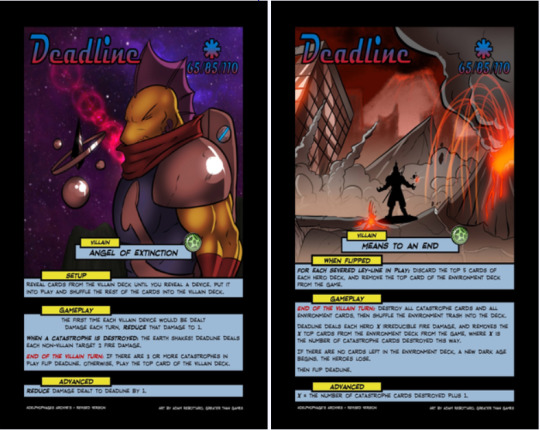
This new Deadline is very much similar to the old deadline, only with a few extra quirks. • His devices are harder to kill. • Catastrophes being destroyed while he is on his front side causes deadline to deal 2 non-villain AOE fire damage. • Severed Ley-lines accelerate the environment destruction but are also less detrimental to trash-based heroes. • H-scaling health Moving on.
The Dreamer

The first half of the Dreamer fight plays very similar. The second half, however, has a tempo-regulating system that “rewards” heroes doing well with more projections (which is technically good, since the goal is to chew through them as fast as possible) but lays off on the extra projections if you’re a little slow on the projection destroying. (Do note that you’re still better off destroying them fast if possible.) My only gripe was that I played a game where I ended up seeing pretty much all the projections in the first half and the second half was mostly spent revealing duds (not to mention that shuffling back in the duds only increases he probability of hitting duds in later reveals, at least theoretically). The 3 Violent Nightmares in the deck are there to help prevent these situations, so I don’t think I would recommend changing it to discard them, this was just an off situation. (Then again, old Dreamer could encounter very similar situations, so that’s just an inherent problem of the deck.) Only thing I could think of is maybe adding an end of turn ability or adding to the start of turn ability (either before or after), “If there are no projections in play, shuffle the villain trash into the villain deck” or even just the projections, but that’s quite a bit more to keep track of an unlikely payoff that I’m not sure it would be worth it.
Infinitor
There isn’t one for Infinitor. Honestly, base infinitor is in a pretty good spot (although ally infinitor is ridiculously easy except in challenge or ultimate mode).
Iron Legacy: Justice for All
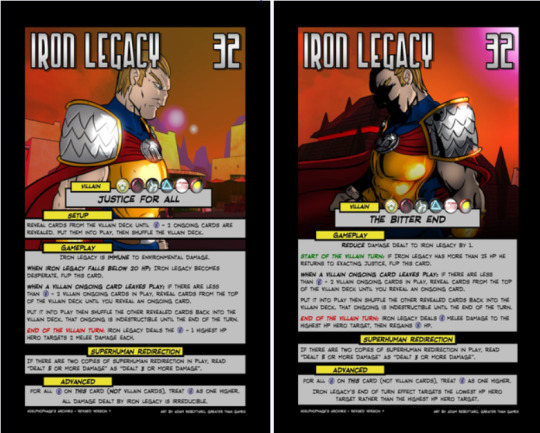
Oh boy, Iron Legacy. out of the three most difficult bosses pre-vengeance, at least iron legacy was kind enough to kill you or die within like 10 minutes.
The first thing you’ll probably check is whether the end of turn effects do less damage, and the front one certainly does (the back one does more IIRC but now targets the highest HP unless playing on Advanced. It also heals 1 point less IIRC.)
The second thing you’ll check and notice and is that his H-scaling mechanic revolves around H-2 Ongoings: he starts with that many (rather than H), but you’re probably not going to get him to less than H-2 Ongoings. Overall, he still hits like a ton of bricks and not being able to clear out all his Ongoings makes him a persistent threat, but those two fewer Ongoings at the start really do make a huge difference in making him beatable.
Kaargra Warfang: Ruler of the Pit

Remember what I said about Iron Legacy making the game nice and quick? yeah, Kaargra Warfang didn’t play like that. I think I can say without exaggeration that old Kaargra Warfang has more bookkeeping than OblivAeon.
I’m guessing you probably can’t read the altered Crowd’s favor and Bloodsworn Coliseum, so I’ll just type out their texts, with my commentary in parantheses and italics. Bloodsworn Coliseum [Cards] This card, the Crowd’s favour card and Title cards are not considered hero, villain or environment cards. (And apparently, the Oxford comma isn’t considered a thing either.) This card and the Crowd’s favour card are indestructible. When a target is destroyed, destroy any Titles under it. When a title is destroyed, put it in the title discard pile. (You mean Title Trash?) When the Title Deck is empty, shuffle the title discard pile into it. [Titles] End of the villain turn: Move one Title next to this card under the highest HP gladiator. Destroy all other titles next to this card. Then play Title cards until there are 3 titles next to this card.
Crowd’s Favor [Hero Favour] Add two tokens to the hero favour pool when... • a villain target is destroyed • A title is moved under a hero target If there are ever 4xH tokens in the hero favour pool and Kaargra Warfang is on the “Ruler of the Pit” side, flip her. (And she will then proceed to require you to ignore the text on this card and make it almost irrelevant except when Fickle Fans happens.)
You may notice that ability to gain Titles only happens 3 at a time and the gladiators can get one of them that you didn’t win during the previous round. You may notice that the purpose of Crowd’s favor is to get kaargra to get off her chair and into the fray so that you can beat her down to win. You may notice a complete lack of referencing bloodsworn pool tokens among those two above cards and ask, "Are they still relevant?” The answer: yes. At the end of the villain turn, kaargra deals each hero x projectile damage, where X is the number of tokens in the bloodsworn favour pool divided by 4, rounded down, and then adds 2 tokens to that pool. You’ll also notice that she’s a target that’s immune to damage. that’s pretty much just to avoid her flipping prematurely. This does have some other interactions, but a safeguard on the back side helps stop it from being too relevant.
Overall, the play experience is much more enjoyable and feels decently beatable if you get a good set of titles early on.
Kismet: Twist of Fate
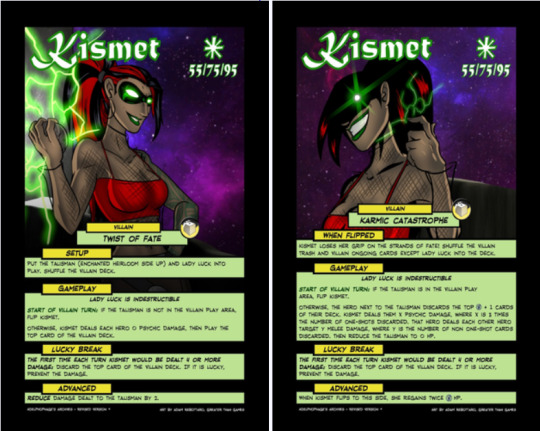
Old Kismet was a great idea done poorly - it’s clear she wants to keep the Talisman, but it’s so easy to take it away from her and use it against her that the fight just doesn’t go anywhere. Her unsubtle trickster promo is fascinating, but it still hinges on the idea of giving the heroes an extremely useful power and giving them the option to attack it and put it back to get it a few turnslater on a different hero. This idea is quite different from either of those. Here, Kismet builds up power with Jinxes and releases a (usually small) AOE attack every turn. An indestructible Lady Luck makes destroying her Ongoings very unreliable. The talisman acts as the kill switch, as using it will put back all her non-Lady Luck ongoings, trigger a rather large AOE, give her back the Talisman at full health. The game becomes managing a cycle of jinxes and AOEs vs the potential massive burst damage. Oh yeah, and for some reason, she is somewhat reliably unable to be hurt by large damage attacks.
The battle is an interesting and unique experience, albeit a little frustrating when you’re trying to destroy an Ongoing when Lady Luck says “nope”.
La Capitan: Paradoxical Pirate

La Capitan has always been a fiddly battle. This version helps a lot with this, but it doesn’t make it stable.
First thing to note is that the Timeship actually plays a very different role in this fight, with its actual abilities rarely ever used, instead mostly just being a marker for whether the back side can deal damage or not. Additionally, Raiding Party triggering the end of turn clause that flips her and skips all other ‘end of villain turn’ clauses ensures you don’t get overly swarmed.
Honestly, I don’t have much to say about this fight. I still don’t enjoy this villain, but it’s better than the official card.
Progeny: The Messenger
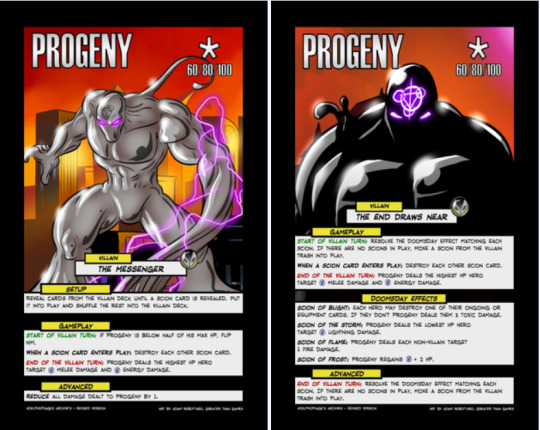
I always found Progeny boring, due to it basically being the same fight throughout with little variation. This variation helps a bit, but overall, I still find it boring.
To go over the differences: • There’s only at most 1 Scion out at a time, generally. This actually fits a lot more flavor-wise. • The end of turn effect deals two instances of H to the highest HP hero target rather than 2 AOE, making him much less susceptible to damage fluctuations. (1 DR still has its place, though, as a number of cards in the deck deal damage in chunks of 1.) • he now flips in the middle of the fight in a mechanic very similar to Dark Souls’ heat-up, gaining an additional ability based on the current Scion.
And, yeah, that’s about it. It’s also cool to note that his health is 20xH, which makes sense given how most of his damage is sort-of H-based, either directly or indirectly.
And rather than change each vengeance villain, why not just change the rules of vengeance style entirely? Here we go:
The Gauntlet
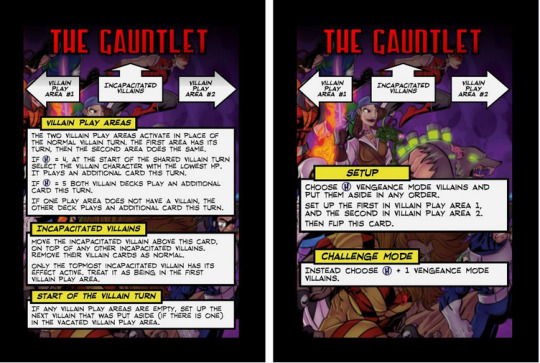
This is an alternative to regular Vengeance play, in which the basic idea is that you only fight H of them, but only two at a time and they both “share” a turn at the start of the turn order. Additionally, they’ll collectively play H-1 cards per turn, keeping the pressure up.
Honestly, at H=3, you might as well play a regular vengeance game, although I can still see the appeal of using this gauntlet format. H=4 is quite fun. H=5 is soul-crushingly difficult, watching a new villain step in completely refreshed while you’re getting battered.
Anyway, my plan is to next look into the unique decks I have played against in Adelphophage’s archives, but before that, I’ll be making one more post soon after this one. I’ll see you all next time, and remember, keep it casual!
1 note
·
View note
Text
Building Strength and Resilience through Facing and Dealing with Life’s Problems

Resilient qualities are not only what we’re born with but also the strengths that we build through encountering life’s challenges and developing the personal and interpersonal skills to meet them. It is one of life’s paradoxes that the worst circumstances can bring the best out of us. According to the Adverse Childhood Experience (ACE) studies performed by Robert Anda (2006) and his team at Kaiser Permanente’s Health Appraisal Clinic in San Diego, we will all experience four or more serious life stressors that may be traumatizing, and according to positive psychology research, most of us will grow from them.
What Do We Mean by Resilience?
Research on resilience used to view resilient qualities as residing exclusively within an individual. Today this research takes the more dynamic view of seeing resilience as an individual’s ability to mobilize supports within a social context. Wong and Wong (2012) write that “In the early days of resilience research, the focus was on ‘the invulnerable child,’ who did better than expected despite adversities and disadvantages . . . [D]evelopmental psychologists were interested in individual differences and the protective factors that contributed to the development of the invulnerable child”. Rutter, however, argues that “resilience may reside in the social context as much as within the individual” (Wong & Wong). “His concept of the ‘steeling’ effect highlights the essence of resilience — the more experience you have in overcoming adversities, the more resilient you will become” (Wong & Wong, 2012).
Wong and Wong propose that certain qualities of behavioral resilience can only be developed from the actual experience of having overcome adversities (Wong & Wong, 2012).
Additionally, they identify at least three prototypical patterns that resilient people appear to display, which may occur in different contexts for different individuals. These are developed as individuals meet life challenges; they are dynamic, constantly evolving qualities rather than qualities residing only within the individual.
Recovery: bouncing back and returning to normal functioning Invulnerability: remaining relatively unscathed by the adversity or trauma Posttraumatic growth: bouncing back and becoming stronger (Wong & Wong, 2012, p. 588). Our Deep Need to Connect: How Early Attachment Can Be Life Enhancing or Traumatizing Our highest and most evolved system, our social engagement system, is activated through our deep urge to communicate and cooperate. From the moment of birth, our mind-body reaches out toward our primary attachment figures to establish the kind of connection that will allow us to survive and find our footing in the world. We fall back on our more primitive systems of defense — such as fight, flight, or freeze — only when we fail to find a sense of resonance and safety in this connection (Porges, 2004).
The body of work that researchers Dan Siegel and Allan Schore have developed, which underlies interpersonal neurobiology, postulates that our skin does not define the boundaries of our beingness; from conception, we resonate in tune or out of tune with those around us (Schore, 1999). Through relational experiences that form and inform our sense of self and through our ability to be cared for and care about others, our capacity for empathy is formed and strengthened (Schore, 1999).
Neuroception, a term coined by Stephen Porges (2004), former Director of the Brain-Body Center at the University of Illinois at Chicago, describes our innate ability to use intricate, meaning-laden, barely perceptible mind-body signals to establish bonds and communicate our needs and intentions. While many of these communications are conscious, still more occur beneath the level of our awareness in that animal-like part of us(Porges, 2004).
Neuroception is a system that has evolved over time to enable humans and mammals to establish the mutually nourishing bonds that we need to survive and thrive. It is also our personal security system that assesses, in the blink of an eye, whether or not the situations that we’re encountering are safe or in some way threatening (Porges, 2004). According to Porges (2004), our neuroception tells us if we can relax and be ourselves or if and when we need to self-protect. If the signals that we’re picking up from others are cold, dismissive, or threatening, that system sets off an inner alarm that is followed by a cascade of mind-body responses honed by eons of evolution to keep us from being harmed. That mind-body system sets off equivalent alerts if we’re facing the proverbial saber-toothed tiger or saber-toothed parent, older sibling, a school bully, or spouse. We brace for harm to our person on the inside as well as on the outside.
When Parents Turn Away
Trauma in the home has a lasting impact. When those we rely on for our basic needs of trust, empathy, and dependency become abusive or neglectful, it constitutes a double whammy. Not only are we being hurt and confused but the very people we’d go to for solace and explanation of what’s going on are the ones causing us pain. We stand scared and braced for danger in those moments, prepared by eons of evolution, ready to flee for safety or stand and fight. If we can do neither, if escape seems impossible because we are children growing up trapped by our own size and dependency within pain engendering families, then something inside of us freezes. Just getting through, just surviving the experience becomes paramount.
Relational trauma impacts all facets of the mind-body social engagement system including limbic resonance, touch, expression, gesture, sign language, and finally words. Consequently, ferreting out just what has hurt us can be a very layered process. A parent who wears a scowl all of the time, for example, and who we couldn’t reach with our attempts at connection or who begrudgingly reached for our hands and dragged us across a street or humiliated us for our small efforts share our feelings to take care of ourselves, can leave a legacy of hurt behind them.
In trauma engendering interactions, “people are not able to use their interactions to regulate their physiological states in relationship . . . they are not getting anything back from the other person that can help them to remain calm and regulated. Quite the opposite. The other person’s behavior is making them go into a scared, braced-for-danger state. Their physiology is being up regulated into a fight/flight mode,” says Porges A failure to successfully engage and create a sense of safety and cooperation or to communicate needs and desires to those people we depend upon for our very survival can be experienced as traumatic. This can set the groundwork for a life long problem with self-regulation.
When Children Withdraw Into Themselves
For small developing children, this refusal of connection can be traumatic if it occurs consistently over time. The child can feel that their needs are somehow incompressible if the parent does not tune into him or her. Small children have little recourse when they are young and dependent. If a parent does not support a comfortable connection, if the parent or caretaker is not available for a caring co-state in which communications on both sides are met with reciprocal attempts to understand and continue to participate in a mutually satisfying feedback loop, the child may feel very alone. They may retreat into their own little world or even dissociate. After all, why continue to try when you are getting nothing back? What about the child who is disciplined not according to their own behavior but by their parent’s mood and left unable to figure out how to act to stay out of trouble? Or how about the kid in a rage-filled home who is told to sit still and listen as the parent dumps a load of pain all over them? What recourse does this child have but to flee internally? When we dissociate, we do not process experiences normally. We do not feel it, think about it, or draw meaning from it.
How Early Relational Trauma Affects Our Relationships
People who have been traumatized in their intimate relationships can find it difficult simply to be in comfortable connection with others. The dependency and vulnerability that is so much a part of intimacy can trigger a person who has been traumatized in their early, intimate relationships into the defensive behaviors that they relied on as children to stay safe and to feel whole rather than splintered. To heal this form of relational trauma, we need to understand what defensive strategies we used to stay safe and then shift these behaviors to be more engaged and nourishing both within our relationships and ourselves. After all, if we constantly brace for danger and rejection, then we are likely to create it. It can become a self-fulfilling prophecy.
The Long-Term Impact of Parental Addiction
Experiences like growing up with parental addiction and the chaos and stress that surround it pop up over and over again as primary causes of toxic stress. Anda and his team were not looking for the effects of addiction in their research however it consistently emerged as an underlying factor in ACE’s. Not only are the effects of parental addiction devastating for children, but addiction is rarely a factor by itself, it is often surrounded by a cluster of other problems such as abuse and neglect. Alcohol and drugs are often used to mask depression and anxiety in the addict but rather than make depression or anxiety better; addiction makes them worse because the depression and anxiety remain undealt with and the addiction becomes a whole, new problem of its own. And being married to an addict creates pain in the partner which undermines their ability to be a present parent, so kids lose two parents. ACEs or adverse childhood experiences tend to cluster; once a home environment is disordered, the risk of witnessing or experiencing emotional, physical, or sexual abuse actually rises dramatically (Anda, et al., 2006).
During one of his lectures, Dr. Anda described why ongoing traumatic experiences such as growing up with addiction, abuse, or neglect in the home can have such tenacious effects: “For an epidemic of influenza, a hurricane, earthquake, or tornado, the worst is quickly over; treatment and recovery efforts can begin. In contrast, the chronic disaster that results from ACEs is insidious and constantly rolling out from generation to generation” (personal communication). If the effects of toxic stress are not understood so that children can receive some sort of understanding and support from home, school, and community, these children simply “vanish from view . . . and randomly reappear — as if they are new entities — in all of your service systems later in childhood, adolescence, and adulthood as clients with behavioral, learning, social, criminal, and chronic health problems” (Anda, et al., 2010).
Growing up is painful; families are only human after all. We will inevitably get hurt. But we need to repair that hurt in some way, and if repair doesn’t happen at or near to the moment of the pain, it will need to happen later. When emotional pain remains split off, it becomes somehow invisible to the naked eye, and it emerges as if it a whole new problem with whole new people. But we need to embrace the challenge as adults of understanding our own childhood ACE-related pain and cleaning up its effects so that it doesn’t become the pain pump for today’s problems.
The idea of growth through suffering or pain is not a new one. The systematic study of it is. Post-traumatic growth (PTG), a phrase coined by Drs. Richard Tedeschi and Lawrence Calhoun — editors of The Handbook of Post Traumatic Growth — describes the positive self-transformation that people undergo through meeting challenges head-on. It refers to a profound, life-altering response to adversity that changes us on the inside as we actively summon the kinds of qualities like fortitude, forgiveness, gratitude, and strength that enable us to not only survive tough circumstances but also thrive. Facing childhood pain and dealing with it rather than acting it out or medicating is part of post-traumatic growth and part of how we create resilience today.
REFERENCES
Anda, R. F., V. J. Felitti, D. W. Brown, D. Chapman, M. Dong, S. R.Schore, A.N. (1999). Affect Regulation and the Origin of the Self. Dan Siegel: The Neurological Basis of Behavior, the Mind, the Brain and Human Relationships Part 1 At the Garrison Institute’s 2011 Climate, Mind and Behavior Symposium, Dr. Dan Siegel of the …
NEUROCEPTION: A Subconscious System for Detecting Threats and Safety STEPHEN W. PORGES University of Illinois at Chicago Copyright 2004 ZERO TO THREE. Reproduced with permission of the copyright holder.
Schore, A.N. (1991), Early superego development: The emergence of shame and narcissistic affect regulation in the practicing period. Psychoanalysis and Contemporary Thought, 14: 187–250.
— — — — — — — (1994), Affect Regulation and the Origin of the Self: The Neurobiology of Emotional Development. Mahwah
Dan Siegel: The Neurological Basis of Behavior, the Mind, the Brain and Human Relationships Part 1 At the Garrison Institute’s 2011 Climate, Mind and Behavior Symposium, Dr. Dan Siegel of the …, M. (2004). Nurturing hidden resilience in troubled youth. Toronto, ON: University of Toronto Press.
Wong, P. T. P. & Wong, L. C. J. (2012). A meaning-centered approach to building youth resilience. In P. T. P. Wong (Ed.), The human quest for meaning: Theories, research, and applications (2nd ed., pp. 585–617). New York, NY: Routledge.
Content Source
0 notes
Text
Why Do You Choose A Harder Path With Men?

What is the appeal of a harder path in life? Why do a lot of women choose this route when it comes to men?
I receive this kind of email a lot: “Please help, Kat. I have a rotation but I really want this man. None of these other men compares. I must have him. I want him to know me better and I want to know him better.”
Or “I know he’s married but I really want to be with him.”
Or “I know he’s not ready because he’s just out of a divorce but I am so attracted to him and I’ve never felt this way about any man in my life before.”
And I usually respond with “You know what the facts are and yet you still set yourself to heartache by choosing a harder path by clinging to an elusive man. Why?”
Yes, ask yourself why, seriously. (Be a high value woman by embracing these 7 traits)
Wanting what you can’t have is ignorance. Doing things that make you unhappy -that aren’t easy for you (apart from going to the gym)- is ignorance. This is a path filled with resistance. Resistance is misery. Ignorance leads to misery.
Where does this ignorance come from?
False view or belief. It’s the view that someone can fulfill your dreams and desire and they’re the one-way ticket to bliss. It’s the belief that when you get validated by your object of obsession’s approval, everything will be right in the universe. Right now, the universe isn’t quite right yet but it will be once you get him.
And of course the very mindset is why the universe is never quite right. Even by sheer chance that you succeed in getting him, you will soon find things about him that are very upsetting to you because he’s still the fountain of your emotional well-being. You are projecting your ideas and fantasy of a holy grail of a relationship on a mere mortal. How many couples divorce after a passionate love affair in the beginning? And didn’t you just divorce your ex yourself?
Newness doesn’t make him “IT.” Newness is why you can’t see beyond now other than the projection of your craving mind. The craving is the problem. Like a sugar rush, it’s very comforting to indulge in it for a while till you crash. And this man will eventually disappoint you as well like other men before him.
So you are creating this misery yourself. A lot of these issues aren’t really issues had you been wise enough to let go when the “going gets tough.” Or it would never get tough to begin with had you been hanging on loosely. Instead you keep investing, keep obsessing, keep projecting and you are sucked in deeper and deeper in the melodrama your craving mind creates.
You’re playing out the movie you create in your head because you are unconscious.

Right now I’m in the middle of Feminine Magnetism of group coaching
We have just finished Module 1 Journey Inward and will start with Module 2 Understanding Men and Four Components of Melting His Heart (you can sign up here). In Module 1 we discuss a lot of aspects of the craving mind and how it creates our reality and suffering.
When you suffer emotionally it’s because you are trapped in the egoic consciousness. Egoic consciousness is marked with grasping and aversion. You grasp when you have contact with pleasure or pleasurable sensations. You want more of it. You want it to stay the same. You want to repeat it day in day out. You are attached.
You avert/resist when you have contact with pain or unpleasurable sensations. You are trying to escape. You want it to change it right here right now. The tension between the two -between chasing and running away from/resisting- renders you restless. You never feel at home. The universe is only right momentarily before it goes back to a state of complete dissatisfaction in no time.
Through the seeing of the mechanics of attachment you will understand why you suffer unnecessarily.

The only way out of that predicament is, naturally, to get out of that very restrictive mode of consciousness by expanding it. How do you expand your consciousness? How do we evolve toward cosmic consciousness?
By practicing awareness. By being mindful of any movement in your inner space. By removing the blinders. By demolishing the false idea of the self. By expanding your conception of self so you include everyone and the entire cosmos in it.
Meditation is how you practice awareness. Meditation has been documented to cause changes in the brain. Meditation gives you “whole brain synchronization.”
Your brain has two hemispheres, left and right. Left hemisphere thinking is logical, practical and mathematical. Right hemisphere thinking is non-linear, intuitive, abstract, big-picture focused, and creative.
Can you guess which brain-half is dominant for you?
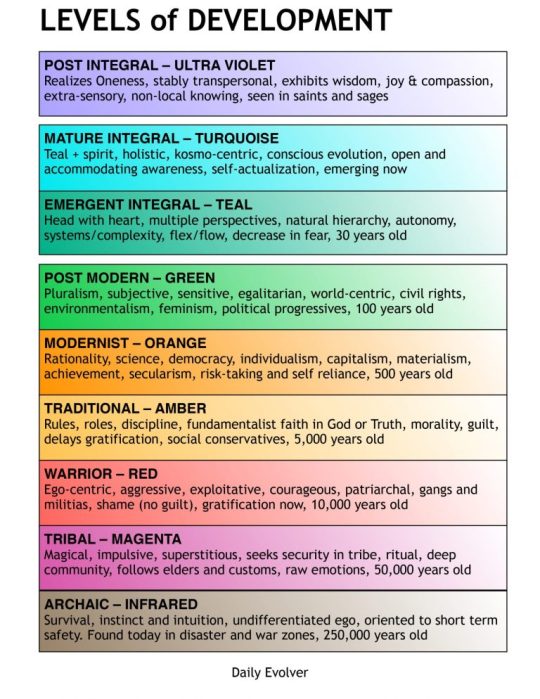
Numerous studies have shown that humanity’s greatest thinkers, inventors, artists, and scientists use both brain hemispheres together, in unison.
Meditation has been scientifically proven to synchronize your left and right brain, allowing extremely beneficial changes in hemispheric thought communication, neural chemistry, and intellectual processing power.
Its true, meditation super-charges your brain!
By destroying the illusory sense of separation. The mental chatters (your stories) are what create this separation. You call them culture, values, political view, religious belief or whatnot. They are just conglomeration of thoughts. People kill thanks to those thoughts. They create enemies with those thoughts. Look at the world over -at our terror plagued societies-, majority of people are still trapped in this level of consciousness (see Ken Wilber chart above: amber and lower).
When you know how to turn down the volume of your mental chatters, you feel natural connection with the cosmos. That is your True Self.
So the very purpose of this program is to usher you to a higher level of consciousness that allows you to see things as they are. You can only see your issues objectively when you can rise above them. You can’t see when you are in the middle of them.
Expanded consciousness will allow you 360° vantage point that allows you to see from every angle. it's like you can see relationships between things and connections from one spot to the next when you are standing on an elevated ground.

“Problems can’t be solved from the level of consciousness that created them.” ~Albert Einstein
Thanks to that you will become 100 times more functional and effective human being. You will accomplish more by struggling less. You will be happier and more peaceful. Life is way easier for you cause you have a 20/20 vision. It’s magical place to be. It’s a totally different world.
You will learn how to be vulnerable and authentic. You can be yourself moment to moment cause you accept yourself without judgment. You are moderate and well-rounded. You have owned your shadow so you are no longer a reactive ball of nerves. You become less and less judgmental. You are at peace with yourself and with the world.
Here are some clear signs that you have cosmic concuoisness :
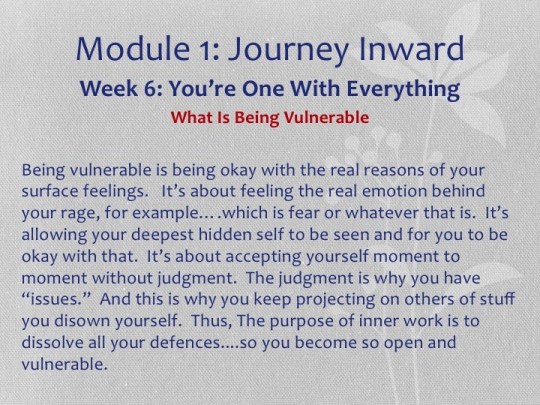
1. You have much fewer lingering I-thoughts. If you are aware you will notice some sort of tension and resistance when you are lost in thoughts about I-me-mine. That is the very definition of the ego. Ego is none other than movement of the mind that runs toward object of obsession/desire (clinging, grasping) and resist pain (aversion). When you’re totally in the moment you are not in the I-thought mode. There is no I in total attention of and merge with the moment. Remember, I think therefore I am. No thought, no “I.”
The dropping away of fear as the self is dropping away. You don’t have the anxiety and fear most people have anymore: fear of the unknown, fear of some imagined future event, fear of not being good enough, fear of failing, etc. The self lives in psychological time. You no longer live in the psychological time of the past and the future. Psychological time leads to fear and sorrow.
You don’t cling and dwell on any particular thought anymore. Nothing has the same meaning anymore. A lot of times you just don’t want to think. If you do think it comes and goes without leaving any mark behind. You’re like a teflon, nothing sticks anymore. You’re light as a feather.
You feel rather than think more. When thinking is put in its right place, it’s no longer domineering your inner realm. As thinking recedes, feeling arises. You feel directly without the influence of thoughts. Thanks to that you have an acute intuition. The paradox is….
Your emotions are mostly flat. You no longer have the ups and downs of feelings most people have day to day. You feel awed, amazed, touched, moved, compassionate, grateful and tranquil much more often than the opposites. Your default emotion is serenity (calm and joy).
You have slowed down your mental process so much you can muster a conscious decision, more often than not, to continue on a passage of thought or abort it knowing first hand the nature of the thought (either willy-nilly futile thinking or creative thinking). You are able to do it cause there is a gap between you and your thoughts. When you realize it is an interesting creative thought process you allow your mind to probe and explore as if you weren’t even involved in it. In the old days, this is how prophets got their revelations. This is how I transmit my insights to you all week to week with my classes. You become a deliberate thinker. You only think (which means continuing on a thought process) when you need and choose to like when you need to solve problems. You become a sole master of your inner world. You are king to your mind, not slave to it. You are a powerful creator of your dream and reality. You are the Seer cause your divine intelligence is activated when mundane thoughts recede to the background.
You are rarely triggered. You become much less neurotic. Being triggered is a sign of denying a certain part of ourselves because it’s so painful or shameful and as a defense mechanism we project that suppressed unclaimed part of us (our shadow) onto the person who triggers us. Being triggered, thus, is a sign of being unconscious.
You are rarely stressed and never depressed. You can see what most people aren’t privileged to see. With that holistic understanding of the world and human nature you vibrate from a much higher frequency than most people. You are the sort of person people come to seek counsel because your vantage point is so all-encompassing.
You don’t judge yourself, hence your lightness of being is a magnet to people and in turn it’s allowing others to alleviate their self-judgment and -in turn- their judgment of others. You like yourself, hence it’s easy for you to like others. Judgment is when we assess a situation not coming from a place of acceptance but a belief that our way is the only way and we need to change others. That means you have that unclaimed side of you. Each time something evokes an emotional reaction in you, it’s an indication that you are fighting your shadow. Hence, you can see that self-judgment goes hand in hand with judgment of others. Self-acceptance goes hand in hand with acceptance of others.
The end of becoming. You are no longer enslaved by impulses, drive, ambition and desire to become somebody that to most people are why they are anxious and unhappy. You are fluid moment to moment not being ruled by an idea of a certain ideal self either now or in the future and you surrender to the flow of life with a mind filled with contentment and curiosity.
The end of sorrow. The end of grasping and resistance is the end of sorrow. The sorrow-free mind is a instrument of life. It surrenders to the flow of life.
“Great seers have always told us to acquire experience. They have said that experience gives us understanding. But it is only the innocent mind, the mind unclouded by experience, totally free from the past; it is only such a mind that can perceive what is reality. If you see the truth of that, if you perceive it for a split second, you will know the extraordinary clarity of a mind that is innocent. This means the falling away of all the encrustations of memory, which is the discarding of the past. But to perceive it, there can be no question of ‘how.’ Your mind must not be distracted by the ‘how’, by the desire for an answer. Such a mind is not an attentive mind. As I said earlier in this talk, in the beginning is the end. In the beginning is the seed of the ending of that which we call sorrow. The ending of sorrow is realized in sorrow itself, not away from sorrow. To move away from sorrow is merely to find an answer, a conclusion, an escape; but sorrow continues. Whereas, if you give it your complete attention, which is to be attentive with your whole being, then you will see that there is an immediate perception in which no time is involved, in which there is no effort, no conflict; and it is this immediate perception, this choiceless awareness that puts an end to sorrow.” ~Krishnamurti
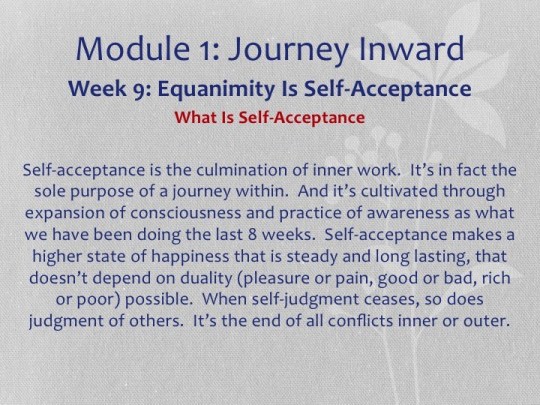
It’s what equanimity is all about and it’s the culmination of this program. Equanimity equals freedom. It’s liberation from duality, from grasping and aversion. You are one with what is because you accept yourself moment to moment. “What is” is however you are moment to moment. You are at peace with it.
You are not separate from what is and the rest of the world.
By focusing on your personal evolution you contribute so much to the evolution of all mankind. This is what this world needs today, more than ever. Only evolution of consciousness will guarantee our survival as a species. We can do this together.
You can now own the entire 11 classes of Module 1 Journey Inward here. This is going to be an investment that will change your life forever. It works much faster and way cheaper than traditional therapy. Not only you’re going to be a total goddess in your relationship with your man but you will also become an agent of change. You’ll be at the leading edge of the evolution of consciousness.
Want to learn more about this very fascinating subject of expansion of consciousness and melt his heart in the process? Here’s the most affordable way:
by working with me face to face in a very relaxed, fun and intimate setting in my own home!
And you will get some of the coaching programs I mention here as bonuses as well so you can start listening to them before coming to the weekend getaway. I promise you it’ll be one of the most worthwhile investments you’ll ever make in your life. Your life will turn upside down for the better after the retreat if you practice all the skills I teach there.
MORE: What If I Tell You That The Only Way To Get Him Is To Let Him Go?
Have you read my book yet? If not grab it here because you will learn so much about a lot of things that haven’t worked for you in your love life and how to fix them. I have just added a new bonus teleclass you don’t want to miss: “How Feminine Magnetism Is The Solution to Every Relationship Problem You Have.”
Please share this with the buttons below and I’d like to hear your comments as well and if you want me to address more scenarios write it on the comment section below (and don’t forget to subscribe to this blog for more insight into the mind of men on the right side bar so you’ll get notified for each new post).
0 notes
Text
4 Test Ideas That Tap into the Concept of Relative Value
What if you could predict how your customers were likely to respond to a specific offer? The book Predictably Irrational by behavioral economist Dan Ariely examines the forces that cause people to behave in ways that seem irrational, but are oddly predictable. I recently discussed one of the concepts presented in the book—relative value—with my colleague in digital optimization consulting, Ivy Portwood.
Ivy has a wealth of experience and knowledge from working closely with Adobe Target customers every day. She shared some thoughts about tests and experiences that apply this concept that I wanted to capture for you. I hope these ideas inspire you to come up your own activities to run in Adobe Target, the optimization and personalization solution of the Adobe Experience Cloud.
But first—what exactly is the concept of relative value?
Relative value explained As a consumer you’re always weighing your options when considering spending your hard-earned cash. You might do that methodically or through gut feel. Relative value plays more into that latter approach—when one option just feels like the best deal compared to the others. For example, let’s say you have a $1 off coupon for a $3.50 ice cream cone. Will you use the coupon? Highly likely. But what about a $1 coupon for a $2000 refrigerator? Even a $45 shirt? Will you use the coupon then? Probably not. A $1 off coupon for an ice cream feels more valuable.
At what point does the perceived value of a discount relative to the item cost entice you to purchase? Similarly, how does the perceived value of an item relative to other options make it feel more valuable? How can you play around with this idea in your testing and experience targeting?
Here are just a few ideas Ivy and I discussed (note that pages of sites shown may have changed since this was posted or may appear differently for you):
Test idea 1: Test different discounts and discount methods If you’re like most consumers, you expect a discount when you shop online for the first time with a company—sign up for a newsletter and get 20% off, free shipping with an order over $50, $10 off your next purchase, and so on. But how can you discover the sweet spot for the discount relative to the price of your item or the total purchase amount?
Research what others are doing, but don’t just blindly follow; consider your brand and what differentiates it. Then determine what approach makes the most sense and test to find out. Don’t just vary discount amounts, vary the language you use in the offers. Try different combinations of perks, too, like testing a discount of 20% off plus free shipping, as the example below shows.
After running your test, remember to consider your results in the context of business goals. Making money is often a main goal, but many companies have other goals—like cost savings. For example, a company may try to shift typically more expensive interactions with customer service representatives on the phone to online self-service. Measure success by how a test or targeting activity contributes to your organization’s specific KPIs, which may be a combination of revenue, units sold, social media goodwill, and customer experience.
Once you’ve zeroed in on the sweet spot for a particular discount method—percent off, cash off, or free shipping—test those winners to see which discount method works best. Take it further by analyzing the characteristics of visitors who respond best to a specific discount method so you can target the right method to the right audience.
Not in retail? The root concept is the same. Credit card companies offer perks like 0% APR on transfers of funds, no annual fee, and miles or cash back. Media and entertainment companies offer various plans, including paying up front for a year for a discount or covering family and friends. All types of companies give discounts for paperless billing, signing up for auto pay, or using self-service features.
Testing allows the customer to tell you through their clicks and purchases what feels most valuable to them.
Test idea 2: Test how you display the offer How you display the offer can impact its perceived value. The travel and hospitality industry has played around with this a lot—from slash-through pricing of the original price (see the image below), a discount % banner, comparisons to prices on other sites, reviews of the hotel and ratings, and a browse mode with a “View Price” or “View Deal” call to action (CTA).
Another example? The New York Times offers three subscription options (shown below)—two are digital only, and one is digital with print. Do any of the elements that differ across options influence you, for example, their order, background color, or size of the rectangular box around the offer? Think about where your eye travels along the page. Many retailers consider the fact that we read from left to right, so display options horizontally. The New York Times recommends the middle offer as the “best value.” Are you convinced that it is? Why or why not?
Looking at the DIRECTV screenshot below, what might they do to their packages page to steer you toward a specific package?
Test idea 3: Test offering fewer choices (in rare cases, adding one or two more) Looking at the Delta Airlines screenshot that follows, you can see the company’s relatively new Basic Economy ticket. This ticket is a step below its “Main Cabin” economy ticket in perks, but also price. Providing another choice may attract customers who might not otherwise purchase a ticket, but it’s worth testing to discover the right number of options. Too few and you miss opportunities, but too many and customers experience the paradox of choice—they have difficulty identifying the option that feels most valuable.
Ideally, the more a customer browses a site and indicates his or her preferences, the more you can personalize and narrow down to the options that truly resonate. If you offer health insurance plans or financial investments, how might you use this idea to help potential customers feel confident in their choices.
Test idea 4: Test payment methods As you can see in the top right of the previous Delta screenshot, Delta also lets its customers purchase with cash, miles (loyalty points), or a combination of miles and cash. Put yourself in the mindset of the customer (after all, we’re all consumers): Would you be more willing to commit to a purchase when you use loyalty points rather than all out-of-pocket cash? And if you’ve invested in accumulating loyalty points, would you be more apt to stick with the Delta brand?
Use your individual experience to practically guide you in forming hypotheses for what might work on your site, but then test to validate. By the way, you could apply this test idea to almost any industry with a loyalty program—retail, telco, technology companies, media and entertainment, and even wholesale distributors.
Get out there and test and target I hope this has you thinking about additional A/B tests and targeting activities you can run in Adobe Target that use the concept of relative value. By the way, Predictably Irrational is a fascinating, fun read that could trigger some new, creative test ideas. It’s available as an audio book, so I recommend just listening to it on your commute in to work. Just as we think we know how our visitors will behave online, we think we know how we’ll behave in a given situation. You’ll often be surprised to discover that the data says otherwise.
The post 4 Test Ideas That Tap into the Concept of Relative Value appeared first on Digital Marketing Blog by Adobe.
from Digital Marketing Blog by Adobe https://blogs.adobe.com/digitalmarketing/personalization/4-test-ideas-tap-concept-relative-value/
0 notes
Text
4 Test Ideas That Tap into the Concept of Relative Value
What if you could predict how your customers were likely to respond to a specific offer? The book Predictably Irrational by behavioral economist Dan Ariely examines the forces that cause people to behave in ways that seem irrational, but are oddly predictable. I recently discussed one of the concepts presented in the book—relative value—with my colleague in digital optimization consulting, Ivy Portwood.
Ivy has a wealth of experience and knowledge from working closely with Adobe Target customers every day. She shared some thoughts about tests and experiences that apply this concept that I wanted to capture for you. I hope these ideas inspire you to come up your own activities to run in Adobe Target, the optimization and personalization solution of the Adobe Experience Cloud.
But first—what exactly is the concept of relative value?
Relative value explained As a consumer you’re always weighing your options when considering spending your hard-earned cash. You might do that methodically or through gut feel. Relative value plays more into that latter approach—when one option just feels like the best deal compared to the others. For example, let’s say you have a $1 off coupon for a $3.50 ice cream cone. Will you use the coupon? Highly likely. But what about a $1 coupon for a $2000 refrigerator? Even a $45 shirt? Will you use the coupon then? Probably not. A $1 off coupon for an ice cream feels more valuable.
At what point does the perceived value of a discount relative to the item cost entice you to purchase? Similarly, how does the perceived value of an item relative to other options make it feel more valuable? How can you play around with this idea in your testing and experience targeting?
Here are just a few ideas Ivy and I discussed (note that pages of sites shown may have changed since this was posted or may appear differently for you):
Test idea 1: Test different discounts and discount methods If you’re like most consumers, you expect a discount when you shop online for the first time with a company—sign up for a newsletter and get 20% off, free shipping with an order over $50, $10 off your next purchase, and so on. But how can you discover the sweet spot for the discount relative to the price of your item or the total purchase amount?
Research what others are doing, but don’t just blindly follow; consider your brand and what differentiates it. Then determine what approach makes the most sense and test to find out. Don’t just vary discount amounts, vary the language you use in the offers. Try different combinations of perks, too, like testing a discount of 20% off plus free shipping, as the example below shows.
After running your test, remember to consider your results in the context of business goals. Making money is often a main goal, but many companies have other goals—like cost savings. For example, a company may try to shift typically more expensive interactions with customer service representatives on the phone to online self-service. Measure success by how a test or targeting activity contributes to your organization’s specific KPIs, which may be a combination of revenue, units sold, social media goodwill, and customer experience.
Once you’ve zeroed in on the sweet spot for a particular discount method—percent off, cash off, or free shipping—test those winners to see which discount method works best. Take it further by analyzing the characteristics of visitors who respond best to a specific discount method so you can target the right method to the right audience.
Not in retail? The root concept is the same. Credit card companies offer perks like 0% APR on transfers of funds, no annual fee, and miles or cash back. Media and entertainment companies offer various plans, including paying up front for a year for a discount or covering family and friends. All types of companies give discounts for paperless billing, signing up for auto pay, or using self-service features.
Testing allows the customer to tell you through their clicks and purchases what feels most valuable to them.
Test idea 2: Test how you display the offer How you display the offer can impact its perceived value. The travel and hospitality industry has played around with this a lot—from slash-through pricing of the original price (see the image below), a discount % banner, comparisons to prices on other sites, reviews of the hotel and ratings, and a browse mode with a “View Price” or “View Deal” call to action (CTA).
Another example? The New York Times offers three subscription options (shown below)—two are digital only, and one is digital with print. Do any of the elements that differ across options influence you, for example, their order, background color, or size of the rectangular box around the offer? Think about where your eye travels along the page. Many retailers consider the fact that we read from left to right, so display options horizontally. The New York Times recommends the middle offer as the “best value.” Are you convinced that it is? Why or why not?
Looking at the DIRECTV screenshot below, what might they do to their packages page to steer you toward a specific package?
Test idea 3: Test offering fewer choices (in rare cases, adding one or two more) Looking at the Delta Airlines screenshot that follows, you can see the company’s relatively new Basic Economy ticket. This ticket is a step below its “Main Cabin” economy ticket in perks, but also price. Providing another choice may attract customers who might not otherwise purchase a ticket, but it’s worth testing to discover the right number of options. Too few and you miss opportunities, but too many and customers experience the paradox of choice—they have difficulty identifying the option that feels most valuable.
Ideally, the more a customer browses a site and indicates his or her preferences, the more you can personalize and narrow down to the options that truly resonate. If you offer health insurance plans or financial investments, how might you use this idea to help potential customers feel confident in their choices.
Test idea 4: Test payment methods As you can see in the top right of the previous Delta screenshot, Delta also lets its customers purchase with cash, miles (loyalty points), or a combination of miles and cash. Put yourself in the mindset of the customer (after all, we’re all consumers): Would you be more willing to commit to a purchase when you use loyalty points rather than all out-of-pocket cash? And if you’ve invested in accumulating loyalty points, would you be more apt to stick with the Delta brand?
Use your individual experience to practically guide you in forming hypotheses for what might work on your site, but then test to validate. By the way, you could apply this test idea to almost any industry with a loyalty program—retail, telco, technology companies, media and entertainment, and even wholesale distributors.
Get out there and test and target I hope this has you thinking about additional A/B tests and targeting activities you can run in Adobe Target that use the concept of relative value. By the way, Predictably Irrational is a fascinating, fun read that could trigger some new, creative test ideas. It’s available as an audio book, so I recommend just listening to it on your commute in to work. Just as we think we know how our visitors will behave online, we think we know how we’ll behave in a given situation. You’ll often be surprised to discover that the data says otherwise.
The post 4 Test Ideas That Tap into the Concept of Relative Value appeared first on Digital Marketing Blog by Adobe.
from Digital Marketing Blog by Adobe https://blogs.adobe.com/digitalmarketing/personalization/4-test-ideas-tap-concept-relative-value/
0 notes
Text
Go With the Flow
While composing a song, Charla McCutcheon sometimes loses track of time.
“I’ll start playing music at 7 or 8 at night, and the next thing I know, it’s 4 a.m.,” says the New York City–based musician.
She also loses a sense of her physical self. “I’m so into the music that I forget I’m even present; it just feels like I’m part of the creation.” Sometimes she’ll even be surprised when she hears the songs, as if someone else wrote them.
Most of us experience this feeling at some point — losing track of time and space while involved in an activity we love. Athletes often describe this state as “being in the zone.” Psychologists sometimes refer to it as “flow.” That term, coined in the mid-1970s by the Hungarian social psychologist Mihaly Csikszentmihalyi, PhD, is gaining new relevance today as we struggle to focus amid a media landscape filled with near-constant distractions.
Musicians, artists, and athletes cultivate flow states deliberately, whether they’re aware of the concept or not. But the experience is not reserved for creative types: You can get into flow while cleaning your garage, weeding your garden, or cooking a meal. It’s less about the activity than the relationship between the doer and the thing being done. If an activity requires some skill, and you love it and are good at it, you can easily lose yourself in it.
The connection between flow states and happiness has been well documented, most notably in Csikszentmihalyi’s seminal 1990 book, Flow: The Psychology of Optimal Experience. But what’s just coming to light is the link between flow and our overall health and well-being — which can suffer without it.
This fact is more pertinent today than ever. Deep attention is under siege. With Facebook, Twitter, and Instagram — not to mention plain old Web browsing, emailing, and texting — we’ve never been so inundated with distractions. Staying focused on one task can feel nearly impossible as our phones light up with incoming texts or notifications that a photo on Instagram has garnered another like.
Our efforts to multitask our way through all this are not only doomed to fail, they’re also a threat to our health. “Multitasking creates a dopamine-addiction feedback loop, effectively rewarding the brain for losing focus and for constantly searching for external stimulation,” notes neuroscientist Daniel J. Levitin, PhD, author of The Organized Mind: Thinking Straight in the Age of Information Overload.
Writing in the Guardian, Levitin explains why the brain is so vulnerable to distraction: “The prefrontal cortex has a novelty bias, meaning that its attention can be easily hijacked by something new — the proverbial shiny objects we use to entice infants, puppies, and kittens.”
We can, in other words, become biologically addicted to checking our phones. The irony here, Levitin adds, is that “the very brain region we need to rely on for staying on task is easily distracted.”
The best antidote to constant distraction is to create the time and space necessary to becoming fully immersed in a task — to get into flow — and to continually challenge ourselves so we satisfy the brain’s desire for novelty. First, though, we need to learn how to create the right conditions, which involves putting away digital distractions, and understand why it’s worth the effort.
Your Body on Flow
Persistent distraction is hard on the body. The dopamine-addiction loop floods our systems with cortisol and adrenaline, two stress-related hormones that can wreak havoc when they run high for extended periods of time.
“When we’re stressed out or frustrated, we go into fight-or-flight mode,” explains Elizabeth Frates, MD, an assistant professor of physical medicine and rehabilitation at Harvard who specializes in lifestyle medicine. “There’s no actual lion in front of us, but it feels like there is one. Our sympathetic nervous system is activated, increasing our respiratory rate, increasing our heart rate, and shunting blood from our digestive system to our muscles so we are not able to digest our food properly. Instead, we are ready to ‘fight or flee’ using our muscles.”
Prolonged periods of stress can suppress the immune system, so we’re more likely to catch colds and take longer to recover from them. It can also lead to insomnia, which has been linked to a host of health issues.
Flow, by contrast, triggers the opposite of the fight-or-flight response, Frates says. When we’re in a flow state, the parasympathetic nervous system is activated, releasing a cascade of calming hormones associated with the rest-and-digest response. Breathing becomes more relaxed, muscles loosen, and heart rate slows. The specific biochemistry associated with flow will vary depending on the activity (writing a poem versus going out for a run, for example), but the overall benefits to health and well-being are the same.
Addiction specialist Judson Brewer, MD, PhD, a neuroscientist and associate professor of medicine at the University of Massachusetts Medical School, studies the brain activity of subjects who are in flow. Using MRI scans, Brewer and his colleagues have observed how the brain reacts during a stressful state (for example, while craving something), as well as when the subject was deeply focused on a task.
They found the posterior cingulate cortex area of the brain (a key node in the default-mode network, responsible for automatic behaviors) was active when craving, and calm while the subject was concentrating.
This observation allows researchers to bridge the gap between subjective experiences and measurable brain activity, Brewer says. It makes clear that concentration calms the brain.
Flow is “critical for the survival of our species,” he continues, because we need deep concentration to evolve or create new and necessary skills.
Still, he notes an important paradox: “If you try to get into flow, you’re going to end up moving in the opposite direction. It’s like that line in The Empire Strikes Back when Yoda says, ‘Do or do not — there is no try,’ because when there’s no trying there’s just doing.”
The Distracted Brain
Nonetheless, there are occasions when we are more likely to find our flow. Csikszentmihalyi suggests starting with a task challenging enough to keep you engaged but not so hard that it leaves you frustrated. We find flow wherever we’re able to lose ourselves in deep concentration, whether that’s in a lab analyzing tissues or on the mat in yoga class.
This type of focus, explains Brewer, is the opposite of losing track of time while you wander from post to post on Facebook. “One is zoning in,” he says, “and one is zoning out.”
Zoning out can lead to misery. Brewer cites a Harvard University study in which researchers contacted participants throughout the day to see if they were paying attention: Were they present and focused on a task, their surroundings, or the person with them, or were they ruminating distractedly about the past or the future? Researchers also asked how happy the subjects felt. The findings were disheartening.
“Forty-seven percent of the time, people were lost in mind wandering. Past, future, but not here,” Brewer notes. Subjects in this state also reported that they were decidedly less happy.
So when it comes to addictive distractions like Facebook, Twitter, and Instagram, things get sticky. “These technologies provide an intermittent reinforcement process that hijacks our reward brain pathways — the same neural pathways that get activated when we use drugs,” says Brewer. “We get so caught up in them that we’re not consciously aware of what we’re doing.”
Before long, we become addicted to the short-term pleasures of distrac-tions that make us measurably less happy overall.
Social media makes the need for flow even more imperative, Brewer argues. Cultivating concentration isn’t merely a safeguard against the harmful effects of distraction; it actually offers mental benefits on its own.
Flow states, for example, can protect our brains as we age. A study published in the Journal of Neuropsychiatry and Clinical Neurosciences examined the effects of cognitive training, including knitting, quilting, reading, and playing games, in subjects aged 70 to 89. Researchers found that those activities — unlike traveling or socializing — were associated with sustained cognitive acuity.
Flow and Emotional Health
The main reason flow feels so good, according to researchers, is because our thoughts, intentions, and actions are working in harmony. We’re not in conflict with ourselves.
“Flow helps to integrate the self because in that state of deep concentration, consciousness is unusually well ordered,” writes Csikszentmihalyi in Flow. “Thoughts, intentions, feelings, and all the senses are focused on the same goal. . . . And when the flow episode is over, one feels more ‘together’ than before, not only internally but also with respect to other people and to the world in general.”
McCutcheon says she felt that sense of togetherness while practicing with her band. She’d arrive at rehearsal with just the slightest idea for a song, she says, “and we would transform it together. It felt like we were of one universal mind.”
“I recognized this alternative state, without knowing the name for it, when I was very young,” says Austin, Texas–based visual artist Holly Sabiston, who began drawing at age 6. She says this concentration helped her thrive in her otherwise chaotic childhood home. “It feels open and unhindered. No constraints,” she says.
The sense of purpose and satisfaction we get from accomplishing a task — especially a challenging one — also contributes to the positive effects of the flow state.
These days, Sabiston finds herself in flow while painting — and during kettlebell workouts. “In the beginning, you have to concentrate really hard. You focus on improving, you count, and you breathe and do as many repetitions in 10 minutes as you can,” she explains.
“There’s something about having a purpose — and having a struc-ture within that purpose — that’s immense-ly satisfying.”
Finding Your Flow
We are all capable of getting into flow, says Christine Carter, PhD, a senior fellow at the Greater Good Science Center at the University of California, Berkeley and author of The Sweet Spot: How to Find Your Groove at Home and Work. She defines it as the “overlay between where we have our greatest strength and greatest ease.”
While flow may seem to be the provenance of artists, musicians, and athletes, Carter believes that these groups simply experience it more often because the “conditions are already there” in what they do.
You may already know where you feel a sense of competence and peace — playing basketball or doing math equations or arranging a bouquet of flowers. If you don’t, and you want to spend more time in a flow state, start with activities that interest you. If you love to cook but always make the same meals, add a new challenge, like bread baking. If you find your bliss in Zumba class, but you already know all the moves, try another style of dance.
Pay attention to your body’s cues. It’s another way to identify activities that put you in flow — and to know when you’re in it. Flow exists on a spectrum of attention, with obsessive addiction at one end and getting completely out of your own way at the other, Brewer explains. At the stressful end, your body feels contracted — shoulders hunched, chest tight. When you’re in complete flow, your body feels expansive and calm, with a focused mind and open heart.
When you find yourself feeling that expanded open quality, what are you doing? Conversely, when you feel contracted, what are you doing? To build more space for flow in your life, start by doing more of what makes you feel open and expanded and less of what makes you feel contracted and tense.
Turning Flow Into a Habit
Once you’ve identified an activity that puts you into flow, you can make it a regular part of your routine. Carter suggests beginning with brief increments.
“Start with 20 minutes,” she says. “Maybe you won’t get much done then, but you’re practicing — you’re doing drills, essentially — and you’re building a practice.” She says the optimal amount of time to be in flow is 90 minutes, so build toward that.
There are ways to train your body to drop into flow quickly, Carter says. “If you do the activity at the same time each day, that can be a cue to your brain.” Maybe you go for a run or sit down to write at your laptop at 7 a.m. every morning.
Having a preflow routine is another cue. Carter says she cleans off her desk as she boils water for tea. Then she turns on her computer, goes to the bathroom, and fetches her tea.
“It’s a list of things that signals to my brain, OK, it’s time. Doing them in the same order each time is also very helpful. That way, one trigger cues another.”
And turn off all your devices so you won’t be interrupted by flashing messages and noisy dings.
After a while, many people who have a flow habit start to recognize emotional shifts cuing them to attend to their project or interest. McCutcheon can feel when she has a streak of creative focus coming on. “It often starts with me getting antsy — whatever I’m doing, I want to be home making music. Whatever else I should be doing, I can’t wait to get home and make music.”
Sabiston experiences a similar emotional crescendo before she begins a major painting. “I didn’t recognize this until further into my career, but I almost always spend a day crying before I begin work on a big project. Now I give myself permission to have a cry fest. That’s how I get into the zone.”
Defending Your Flow
For many of us, the work involved in our chosen careers puts us into flow. A study Csikszentmihalyi led at the University of Chicago found that flow states occurred three times more often when the participants were at work than during their free time. So if you tend to find your flow while journaling or jogging or hunting for wild mushrooms, you may need to defend that blissful space.
Carter recommends building a “fortress against interruption” when trying to set the right conditions for flow: Silence your phone (even better, turn it off and move it out of sight) and put on comfortable clothes. “If you can’t concentrate,” she says, “you can’t be in your sweet spot. Period.”
The same technique can be applied to friends and family who may try to interrupt you while you’re in flow. They may not understand how important this activity is to you, even if you explain. That’s OK. Listen to your feelings and be clear about your need for time. And don’t be surprised if they notice your calm concentration and suddenly start to find more time for their own flow activities. Healthy habits are contagious, too.
Get the full story at https://experiencelife.com/article/go-with-the-flow-2/
0 notes
Text
Go With the Flow
While composing a song, Charla McCutcheon sometimes loses track of time.
“I’ll start playing music at 7 or 8 at night, and the next thing I know, it’s 4 a.m.,” says the New York City–based musician.
She also loses a sense of her physical self. “I’m so into the music that I forget I’m even present; it just feels like I’m part of the creation.” Sometimes she’ll even be surprised when she hears the songs, as if someone else wrote them.
Most of us experience this feeling at some point — losing track of time and space while involved in an activity we love. Athletes often describe this state as “being in the zone.” Psychologists sometimes refer to it as “flow.” That term, coined in the mid-1970s by the Hungarian social psychologist Mihaly Csikszentmihalyi, PhD, is gaining new relevance today as we struggle to focus amid a media landscape filled with near-constant distractions.
Musicians, artists, and athletes cultivate flow states deliberately, whether they’re aware of the concept or not. But the experience is not reserved for creative types: You can get into flow while cleaning your garage, weeding your garden, or cooking a meal. It’s less about the activity than the relationship between the doer and the thing being done. If an activity requires some skill, and you love it and are good at it, you can easily lose yourself in it.
The connection between flow states and happiness has been well documented, most notably in Csikszentmihalyi’s seminal 1990 book, Flow: The Psychology of Optimal Experience. But what’s just coming to light is the link between flow and our overall health and well-being — which can suffer without it.
This fact is more pertinent today than ever. Deep attention is under siege. With Facebook, Twitter, and Instagram — not to mention plain old Web browsing, emailing, and texting — we’ve never been so inundated with distractions. Staying focused on one task can feel nearly impossible as our phones light up with incoming texts or notifications that a photo on Instagram has garnered another like.
Our efforts to multitask our way through all this are not only doomed to fail, they’re also a threat to our health. “Multitasking creates a dopamine-addiction feedback loop, effectively rewarding the brain for losing focus and for constantly searching for external stimulation,” notes neuroscientist Daniel J. Levitin, PhD, author of The Organized Mind: Thinking Straight in the Age of Information Overload.
Writing in the Guardian, Levitin explains why the brain is so vulnerable to distraction: “The prefrontal cortex has a novelty bias, meaning that its attention can be easily hijacked by something new — the proverbial shiny objects we use to entice infants, puppies, and kittens.”
We can, in other words, become biologically addicted to checking our phones. The irony here, Levitin adds, is that “the very brain region we need to rely on for staying on task is easily distracted.”
The best antidote to constant distraction is to create the time and space necessary to becoming fully immersed in a task — to get into flow — and to continually challenge ourselves so we satisfy the brain’s desire for novelty. First, though, we need to learn how to create the right conditions, which involves putting away digital distractions, and understand why it’s worth the effort.
Your Body on Flow
Persistent distraction is hard on the body. The dopamine-addiction loop floods our systems with cortisol and adrenaline, two stress-related hormones that can wreak havoc when they run high for extended periods of time.
“When we’re stressed out or frustrated, we go into fight-or-flight mode,” explains Elizabeth Frates, MD, an assistant professor of physical medicine and rehabilitation at Harvard who specializes in lifestyle medicine. “There’s no actual lion in front of us, but it feels like there is one. Our sympathetic nervous system is activated, increasing our respiratory rate, increasing our heart rate, and shunting blood from our digestive system to our muscles so we are not able to digest our food properly. Instead, we are ready to ‘fight or flee’ using our muscles.”
Prolonged periods of stress can suppress the immune system, so we’re more likely to catch colds and take longer to recover from them. It can also lead to insomnia, which has been linked to a host of health issues.
Flow, by contrast, triggers the opposite of the fight-or-flight response, Frates says. When we’re in a flow state, the parasympathetic nervous system is activated, releasing a cascade of calming hormones associated with the rest-and-digest response. Breathing becomes more relaxed, muscles loosen, and heart rate slows. The specific biochemistry associated with flow will vary depending on the activity (writing a poem versus going out for a run, for example), but the overall benefits to health and well-being are the same.
Addiction specialist Judson Brewer, MD, PhD, a neuroscientist and associate professor of medicine at the University of Massachusetts Medical School, studies the brain activity of subjects who are in flow. Using MRI scans, Brewer and his colleagues have observed how the brain reacts during a stressful state (for example, while craving something), as well as when the subject was deeply focused on a task.
They found the posterior cingulate cortex area of the brain (a key node in the default-mode network, responsible for automatic behaviors) was active when craving, and calm while the subject was concentrating.
This observation allows researchers to bridge the gap between subjective experiences and measurable brain activity, Brewer says. It makes clear that concentration calms the brain.
Flow is “critical for the survival of our species,” he continues, because we need deep concentration to evolve or create new and necessary skills.
Still, he notes an important paradox: “If you try to get into flow, you’re going to end up moving in the opposite direction. It’s like that line in The Empire Strikes Back when Yoda says, ‘Do or do not — there is no try,’ because when there’s no trying there’s just doing.”
The Distracted Brain
Nonetheless, there are occasions when we are more likely to find our flow. Csikszentmihalyi suggests starting with a task challenging enough to keep you engaged but not so hard that it leaves you frustrated. We find flow wherever we’re able to lose ourselves in deep concentration, whether that’s in a lab analyzing tissues or on the mat in yoga class.
This type of focus, explains Brewer, is the opposite of losing track of time while you wander from post to post on Facebook. “One is zoning in,” he says, “and one is zoning out.”
Zoning out can lead to misery. Brewer cites a Harvard University study in which researchers contacted participants throughout the day to see if they were paying attention: Were they present and focused on a task, their surroundings, or the person with them, or were they ruminating distractedly about the past or the future? Researchers also asked how happy the subjects felt. The findings were disheartening.
“Forty-seven percent of the time, people were lost in mind wandering. Past, future, but not here,” Brewer notes. Subjects in this state also reported that they were decidedly less happy.
So when it comes to addictive distractions like Facebook, Twitter, and Instagram, things get sticky. “These technologies provide an intermittent reinforcement process that hijacks our reward brain pathways — the same neural pathways that get activated when we use drugs,” says Brewer. “We get so caught up in them that we’re not consciously aware of what we’re doing.”
Before long, we become addicted to the short-term pleasures of distrac-tions that make us measurably less happy overall.
Social media makes the need for flow even more imperative, Brewer argues. Cultivating concentration isn’t merely a safeguard against the harmful effects of distraction; it actually offers mental benefits on its own.
Flow states, for example, can protect our brains as we age. A study published in the Journal of Neuropsychiatry and Clinical Neurosciences examined the effects of cognitive training, including knitting, quilting, reading, and playing games, in subjects aged 70 to 89. Researchers found that those activities — unlike traveling or socializing — were associated with sustained cognitive acuity.
Flow and Emotional Health
The main reason flow feels so good, according to researchers, is because our thoughts, intentions, and actions are working in harmony. We’re not in conflict with ourselves.
“Flow helps to integrate the self because in that state of deep concentration, consciousness is unusually well ordered,” writes Csikszentmihalyi in Flow. “Thoughts, intentions, feelings, and all the senses are focused on the same goal. . . . And when the flow episode is over, one feels more ‘together’ than before, not only internally but also with respect to other people and to the world in general.”
McCutcheon says she felt that sense of togetherness while practicing with her band. She’d arrive at rehearsal with just the slightest idea for a song, she says, “and we would transform it together. It felt like we were of one universal mind.”
“I recognized this alternative state, without knowing the name for it, when I was very young,” says Austin, Texas–based visual artist Holly Sabiston, who began drawing at age 6. She says this concentration helped her thrive in her otherwise chaotic childhood home. “It feels open and unhindered. No constraints,” she says.
The sense of purpose and satisfaction we get from accomplishing a task — especially a challenging one — also contributes to the positive effects of the flow state.
These days, Sabiston finds herself in flow while painting — and during kettlebell workouts. “In the beginning, you have to concentrate really hard. You focus on improving, you count, and you breathe and do as many repetitions in 10 minutes as you can,” she explains.
“There’s something about having a purpose — and having a struc-ture within that purpose — that’s immense-ly satisfying.”
Finding Your Flow
We are all capable of getting into flow, says Christine Carter, PhD, a senior fellow at the Greater Good Science Center at the University of California, Berkeley and author of The Sweet Spot: How to Find Your Groove at Home and Work. She defines it as the “overlay between where we have our greatest strength and greatest ease.”
While flow may seem to be the provenance of artists, musicians, and athletes, Carter believes that these groups simply experience it more often because the “conditions are already there” in what they do.
You may already know where you feel a sense of competence and peace — playing basketball or doing math equations or arranging a bouquet of flowers. If you don’t, and you want to spend more time in a flow state, start with activities that interest you. If you love to cook but always make the same meals, add a new challenge, like bread baking. If you find your bliss in Zumba class, but you already know all the moves, try another style of dance.
Pay attention to your body’s cues. It’s another way to identify activities that put you in flow — and to know when you’re in it. Flow exists on a spectrum of attention, with obsessive addiction at one end and getting completely out of your own way at the other, Brewer explains. At the stressful end, your body feels contracted — shoulders hunched, chest tight. When you’re in complete flow, your body feels expansive and calm, with a focused mind and open heart.
When you find yourself feeling that expanded open quality, what are you doing? Conversely, when you feel contracted, what are you doing? To build more space for flow in your life, start by doing more of what makes you feel open and expanded and less of what makes you feel contracted and tense.
Turning Flow Into a Habit
Once you’ve identified an activity that puts you into flow, you can make it a regular part of your routine. Carter suggests beginning with brief increments.
“Start with 20 minutes,” she says. “Maybe you won’t get much done then, but you’re practicing — you’re doing drills, essentially — and you’re building a practice.” She says the optimal amount of time to be in flow is 90 minutes, so build toward that.
There are ways to train your body to drop into flow quickly, Carter says. “If you do the activity at the same time each day, that can be a cue to your brain.” Maybe you go for a run or sit down to write at your laptop at 7 a.m. every morning.
Having a preflow routine is another cue. Carter says she cleans off her desk as she boils water for tea. Then she turns on her computer, goes to the bathroom, and fetches her tea.
“It’s a list of things that signals to my brain, OK, it’s time. Doing them in the same order each time is also very helpful. That way, one trigger cues another.”
And turn off all your devices so you won’t be interrupted by flashing messages and noisy dings.
After a while, many people who have a flow habit start to recognize emotional shifts cuing them to attend to their project or interest. McCutcheon can feel when she has a streak of creative focus coming on. “It often starts with me getting antsy — whatever I’m doing, I want to be home making music. Whatever else I should be doing, I can’t wait to get home and make music.”
Sabiston experiences a similar emotional crescendo before she begins a major painting. “I didn’t recognize this until further into my career, but I almost always spend a day crying before I begin work on a big project. Now I give myself permission to have a cry fest. That’s how I get into the zone.”
Defending Your Flow
For many of us, the work involved in our chosen careers puts us into flow. A study Csikszentmihalyi led at the University of Chicago found that flow states occurred three times more often when the participants were at work than during their free time. So if you tend to find your flow while journaling or jogging or hunting for wild mushrooms, you may need to defend that blissful space.
Carter recommends building a “fortress against interruption” when trying to set the right conditions for flow: Silence your phone (even better, turn it off and move it out of sight) and put on comfortable clothes. “If you can’t concentrate,” she says, “you can’t be in your sweet spot. Period.”
The same technique can be applied to friends and family who may try to interrupt you while you’re in flow. They may not understand how important this activity is to you, even if you explain. That’s OK. Listen to your feelings and be clear about your need for time. And don’t be surprised if they notice your calm concentration and suddenly start to find more time for their own flow activities. Healthy habits are contagious, too.
Get the full story at https://experiencelife.com/article/go-with-the-flow-2/
0 notes
Text
Go With the Flow
While composing a song, Charla McCutcheon sometimes loses track of time.
“I’ll start playing music at 7 or 8 at night, and the next thing I know, it’s 4 a.m.,” says the New York City–based musician.
She also loses a sense of her physical self. “I’m so into the music that I forget I’m even present; it just feels like I’m part of the creation.” Sometimes she’ll even be surprised when she hears the songs, as if someone else wrote them.
Most of us experience this feeling at some point — losing track of time and space while involved in an activity we love. Athletes often describe this state as “being in the zone.” Psychologists sometimes refer to it as “flow.” That term, coined in the mid-1970s by the Hungarian social psychologist Mihaly Csikszentmihalyi, PhD, is gaining new relevance today as we struggle to focus amid a media landscape filled with near-constant distractions.
Musicians, artists, and athletes cultivate flow states deliberately, whether they’re aware of the concept or not. But the experience is not reserved for creative types: You can get into flow while cleaning your garage, weeding your garden, or cooking a meal. It’s less about the activity than the relationship between the doer and the thing being done. If an activity requires some skill, and you love it and are good at it, you can easily lose yourself in it.
The connection between flow states and happiness has been well documented, most notably in Csikszentmihalyi’s seminal 1990 book, Flow: The Psychology of Optimal Experience. But what’s just coming to light is the link between flow and our overall health and well-being — which can suffer without it.
This fact is more pertinent today than ever. Deep attention is under siege. With Facebook, Twitter, and Instagram — not to mention plain old Web browsing, emailing, and texting — we’ve never been so inundated with distractions. Staying focused on one task can feel nearly impossible as our phones light up with incoming texts or notifications that a photo on Instagram has garnered another like.
Our efforts to multitask our way through all this are not only doomed to fail, they’re also a threat to our health. “Multitasking creates a dopamine-addiction feedback loop, effectively rewarding the brain for losing focus and for constantly searching for external stimulation,” notes neuroscientist Daniel J. Levitin, PhD, author of The Organized Mind: Thinking Straight in the Age of Information Overload.
Writing in the Guardian, Levitin explains why the brain is so vulnerable to distraction: “The prefrontal cortex has a novelty bias, meaning that its attention can be easily hijacked by something new — the proverbial shiny objects we use to entice infants, puppies, and kittens.”
We can, in other words, become biologically addicted to checking our phones. The irony here, Levitin adds, is that “the very brain region we need to rely on for staying on task is easily distracted.”
The best antidote to constant distraction is to create the time and space necessary to becoming fully immersed in a task — to get into flow — and to continually challenge ourselves so we satisfy the brain’s desire for novelty. First, though, we need to learn how to create the right conditions, which involves putting away digital distractions, and understand why it’s worth the effort.
Your Body on Flow
Persistent distraction is hard on the body. The dopamine-addiction loop floods our systems with cortisol and adrenaline, two stress-related hormones that can wreak havoc when they run high for extended periods of time.
“When we’re stressed out or frustrated, we go into fight-or-flight mode,” explains Elizabeth Frates, MD, an assistant professor of physical medicine and rehabilitation at Harvard who specializes in lifestyle medicine. “There’s no actual lion in front of us, but it feels like there is one. Our sympathetic nervous system is activated, increasing our respiratory rate, increasing our heart rate, and shunting blood from our digestive system to our muscles so we are not able to digest our food properly. Instead, we are ready to ‘fight or flee’ using our muscles.”
Prolonged periods of stress can suppress the immune system, so we’re more likely to catch colds and take longer to recover from them. It can also lead to insomnia, which has been linked to a host of health issues.
Flow, by contrast, triggers the opposite of the fight-or-flight response, Frates says. When we’re in a flow state, the parasympathetic nervous system is activated, releasing a cascade of calming hormones associated with the rest-and-digest response. Breathing becomes more relaxed, muscles loosen, and heart rate slows. The specific biochemistry associated with flow will vary depending on the activity (writing a poem versus going out for a run, for example), but the overall benefits to health and well-being are the same.
Addiction specialist Judson Brewer, MD, PhD, a neuroscientist and associate professor of medicine at the University of Massachusetts Medical School, studies the brain activity of subjects who are in flow. Using MRI scans, Brewer and his colleagues have observed how the brain reacts during a stressful state (for example, while craving something), as well as when the subject was deeply focused on a task.
They found the posterior cingulate cortex area of the brain (a key node in the default-mode network, responsible for automatic behaviors) was active when craving, and calm while the subject was concentrating.
This observation allows researchers to bridge the gap between subjective experiences and measurable brain activity, Brewer says. It makes clear that concentration calms the brain.
Flow is “critical for the survival of our species,” he continues, because we need deep concentration to evolve or create new and necessary skills.
Still, he notes an important paradox: “If you try to get into flow, you’re going to end up moving in the opposite direction. It’s like that line in The Empire Strikes Back when Yoda says, ‘Do or do not — there is no try,’ because when there’s no trying there’s just doing.”
The Distracted Brain
Nonetheless, there are occasions when we are more likely to find our flow. Csikszentmihalyi suggests starting with a task challenging enough to keep you engaged but not so hard that it leaves you frustrated. We find flow wherever we’re able to lose ourselves in deep concentration, whether that’s in a lab analyzing tissues or on the mat in yoga class.
This type of focus, explains Brewer, is the opposite of losing track of time while you wander from post to post on Facebook. “One is zoning in,” he says, “and one is zoning out.”
Zoning out can lead to misery. Brewer cites a Harvard University study in which researchers contacted participants throughout the day to see if they were paying attention: Were they present and focused on a task, their surroundings, or the person with them, or were they ruminating distractedly about the past or the future? Researchers also asked how happy the subjects felt. The findings were disheartening.
“Forty-seven percent of the time, people were lost in mind wandering. Past, future, but not here,” Brewer notes. Subjects in this state also reported that they were decidedly less happy.
So when it comes to addictive distractions like Facebook, Twitter, and Instagram, things get sticky. “These technologies provide an intermittent reinforcement process that hijacks our reward brain pathways — the same neural pathways that get activated when we use drugs,” says Brewer. “We get so caught up in them that we’re not consciously aware of what we’re doing.”
Before long, we become addicted to the short-term pleasures of distrac-tions that make us measurably less happy overall.
Social media makes the need for flow even more imperative, Brewer argues. Cultivating concentration isn’t merely a safeguard against the harmful effects of distraction; it actually offers mental benefits on its own.
Flow states, for example, can protect our brains as we age. A study published in the Journal of Neuropsychiatry and Clinical Neurosciences examined the effects of cognitive training, including knitting, quilting, reading, and playing games, in subjects aged 70 to 89. Researchers found that those activities — unlike traveling or socializing — were associated with sustained cognitive acuity.
Flow and Emotional Health
The main reason flow feels so good, according to researchers, is because our thoughts, intentions, and actions are working in harmony. We’re not in conflict with ourselves.
“Flow helps to integrate the self because in that state of deep concentration, consciousness is unusually well ordered,” writes Csikszentmihalyi in Flow. “Thoughts, intentions, feelings, and all the senses are focused on the same goal. . . . And when the flow episode is over, one feels more ‘together’ than before, not only internally but also with respect to other people and to the world in general.”
McCutcheon says she felt that sense of togetherness while practicing with her band. She’d arrive at rehearsal with just the slightest idea for a song, she says, “and we would transform it together. It felt like we were of one universal mind.”
“I recognized this alternative state, without knowing the name for it, when I was very young,” says Austin, Texas–based visual artist Holly Sabiston, who began drawing at age 6. She says this concentration helped her thrive in her otherwise chaotic childhood home. “It feels open and unhindered. No constraints,” she says.
The sense of purpose and satisfaction we get from accomplishing a task — especially a challenging one — also contributes to the positive effects of the flow state.
These days, Sabiston finds herself in flow while painting — and during kettlebell workouts. “In the beginning, you have to concentrate really hard. You focus on improving, you count, and you breathe and do as many repetitions in 10 minutes as you can,” she explains.
“There’s something about having a purpose — and having a struc-ture within that purpose — that’s immense-ly satisfying.”
Finding Your Flow
We are all capable of getting into flow, says Christine Carter, PhD, a senior fellow at the Greater Good Science Center at the University of California, Berkeley and author of The Sweet Spot: How to Find Your Groove at Home and Work. She defines it as the “overlay between where we have our greatest strength and greatest ease.”
While flow may seem to be the provenance of artists, musicians, and athletes, Carter believes that these groups simply experience it more often because the “conditions are already there” in what they do.
You may already know where you feel a sense of competence and peace — playing basketball or doing math equations or arranging a bouquet of flowers. If you don’t, and you want to spend more time in a flow state, start with activities that interest you. If you love to cook but always make the same meals, add a new challenge, like bread baking. If you find your bliss in Zumba class, but you already know all the moves, try another style of dance.
Pay attention to your body’s cues. It’s another way to identify activities that put you in flow — and to know when you’re in it. Flow exists on a spectrum of attention, with obsessive addiction at one end and getting completely out of your own way at the other, Brewer explains. At the stressful end, your body feels contracted — shoulders hunched, chest tight. When you’re in complete flow, your body feels expansive and calm, with a focused mind and open heart.
When you find yourself feeling that expanded open quality, what are you doing? Conversely, when you feel contracted, what are you doing? To build more space for flow in your life, start by doing more of what makes you feel open and expanded and less of what makes you feel contracted and tense.
Turning Flow Into a Habit
Once you’ve identified an activity that puts you into flow, you can make it a regular part of your routine. Carter suggests beginning with brief increments.
“Start with 20 minutes,” she says. “Maybe you won’t get much done then, but you’re practicing — you’re doing drills, essentially — and you’re building a practice.” She says the optimal amount of time to be in flow is 90 minutes, so build toward that.
There are ways to train your body to drop into flow quickly, Carter says. “If you do the activity at the same time each day, that can be a cue to your brain.” Maybe you go for a run or sit down to write at your laptop at 7 a.m. every morning.
Having a preflow routine is another cue. Carter says she cleans off her desk as she boils water for tea. Then she turns on her computer, goes to the bathroom, and fetches her tea.
“It’s a list of things that signals to my brain, OK, it’s time. Doing them in the same order each time is also very helpful. That way, one trigger cues another.”
And turn off all your devices so you won’t be interrupted by flashing messages and noisy dings.
After a while, many people who have a flow habit start to recognize emotional shifts cuing them to attend to their project or interest. McCutcheon can feel when she has a streak of creative focus coming on. “It often starts with me getting antsy — whatever I’m doing, I want to be home making music. Whatever else I should be doing, I can’t wait to get home and make music.”
Sabiston experiences a similar emotional crescendo before she begins a major painting. “I didn’t recognize this until further into my career, but I almost always spend a day crying before I begin work on a big project. Now I give myself permission to have a cry fest. That’s how I get into the zone.”
Defending Your Flow
For many of us, the work involved in our chosen careers puts us into flow. A study Csikszentmihalyi led at the University of Chicago found that flow states occurred three times more often when the participants were at work than during their free time. So if you tend to find your flow while journaling or jogging or hunting for wild mushrooms, you may need to defend that blissful space.
Carter recommends building a “fortress against interruption” when trying to set the right conditions for flow: Silence your phone (even better, turn it off and move it out of sight) and put on comfortable clothes. “If you can’t concentrate,” she says, “you can’t be in your sweet spot. Period.”
The same technique can be applied to friends and family who may try to interrupt you while you’re in flow. They may not understand how important this activity is to you, even if you explain. That’s OK. Listen to your feelings and be clear about your need for time. And don’t be surprised if they notice your calm concentration and suddenly start to find more time for their own flow activities. Healthy habits are contagious, too.
Get the full story at https://experiencelife.com/article/go-with-the-flow-2/
0 notes
Text
Go With the Flow
While composing a song, Charla McCutcheon sometimes loses track of time.
“I’ll start playing music at 7 or 8 at night, and the next thing I know, it’s 4 a.m.,” says the New York City–based musician.
She also loses a sense of her physical self. “I’m so into the music that I forget I’m even present; it just feels like I’m part of the creation.” Sometimes she’ll even be surprised when she hears the songs, as if someone else wrote them.
Most of us experience this feeling at some point — losing track of time and space while involved in an activity we love. Athletes often describe this state as “being in the zone.” Psychologists sometimes refer to it as “flow.” That term, coined in the mid-1970s by the Hungarian social psychologist Mihaly Csikszentmihalyi, PhD, is gaining new relevance today as we struggle to focus amid a media landscape filled with near-constant distractions.
Musicians, artists, and athletes cultivate flow states deliberately, whether they’re aware of the concept or not. But the experience is not reserved for creative types: You can get into flow while cleaning your garage, weeding your garden, or cooking a meal. It’s less about the activity than the relationship between the doer and the thing being done. If an activity requires some skill, and you love it and are good at it, you can easily lose yourself in it.
The connection between flow states and happiness has been well documented, most notably in Csikszentmihalyi’s seminal 1990 book, Flow: The Psychology of Optimal Experience. But what’s just coming to light is the link between flow and our overall health and well-being — which can suffer without it.
This fact is more pertinent today than ever. Deep attention is under siege. With Facebook, Twitter, and Instagram — not to mention plain old Web browsing, emailing, and texting — we’ve never been so inundated with distractions. Staying focused on one task can feel nearly impossible as our phones light up with incoming texts or notifications that a photo on Instagram has garnered another like.
Our efforts to multitask our way through all this are not only doomed to fail, they’re also a threat to our health. “Multitasking creates a dopamine-addiction feedback loop, effectively rewarding the brain for losing focus and for constantly searching for external stimulation,” notes neuroscientist Daniel J. Levitin, PhD, author of The Organized Mind: Thinking Straight in the Age of Information Overload.
Writing in the Guardian, Levitin explains why the brain is so vulnerable to distraction: “The prefrontal cortex has a novelty bias, meaning that its attention can be easily hijacked by something new — the proverbial shiny objects we use to entice infants, puppies, and kittens.”
We can, in other words, become biologically addicted to checking our phones. The irony here, Levitin adds, is that “the very brain region we need to rely on for staying on task is easily distracted.”
The best antidote to constant distraction is to create the time and space necessary to becoming fully immersed in a task — to get into flow — and to continually challenge ourselves so we satisfy the brain’s desire for novelty. First, though, we need to learn how to create the right conditions, which involves putting away digital distractions, and understand why it’s worth the effort.
Your Body on Flow
Persistent distraction is hard on the body. The dopamine-addiction loop floods our systems with cortisol and adrenaline, two stress-related hormones that can wreak havoc when they run high for extended periods of time.
“When we’re stressed out or frustrated, we go into fight-or-flight mode,” explains Elizabeth Frates, MD, an assistant professor of physical medicine and rehabilitation at Harvard who specializes in lifestyle medicine. “There’s no actual lion in front of us, but it feels like there is one. Our sympathetic nervous system is activated, increasing our respiratory rate, increasing our heart rate, and shunting blood from our digestive system to our muscles so we are not able to digest our food properly. Instead, we are ready to ‘fight or flee’ using our muscles.”
Prolonged periods of stress can suppress the immune system, so we’re more likely to catch colds and take longer to recover from them. It can also lead to insomnia, which has been linked to a host of health issues.
Flow, by contrast, triggers the opposite of the fight-or-flight response, Frates says. When we’re in a flow state, the parasympathetic nervous system is activated, releasing a cascade of calming hormones associated with the rest-and-digest response. Breathing becomes more relaxed, muscles loosen, and heart rate slows. The specific biochemistry associated with flow will vary depending on the activity (writing a poem versus going out for a run, for example), but the overall benefits to health and well-being are the same.
Addiction specialist Judson Brewer, MD, PhD, a neuroscientist and associate professor of medicine at the University of Massachusetts Medical School, studies the brain activity of subjects who are in flow. Using MRI scans, Brewer and his colleagues have observed how the brain reacts during a stressful state (for example, while craving something), as well as when the subject was deeply focused on a task.
They found the posterior cingulate cortex area of the brain (a key node in the default-mode network, responsible for automatic behaviors) was active when craving, and calm while the subject was concentrating.
This observation allows researchers to bridge the gap between subjective experiences and measurable brain activity, Brewer says. It makes clear that concentration calms the brain.
Flow is “critical for the survival of our species,” he continues, because we need deep concentration to evolve or create new and necessary skills.
Still, he notes an important paradox: “If you try to get into flow, you’re going to end up moving in the opposite direction. It’s like that line in The Empire Strikes Back when Yoda says, ‘Do or do not — there is no try,’ because when there’s no trying there’s just doing.”
The Distracted Brain
Nonetheless, there are occasions when we are more likely to find our flow. Csikszentmihalyi suggests starting with a task challenging enough to keep you engaged but not so hard that it leaves you frustrated. We find flow wherever we’re able to lose ourselves in deep concentration, whether that’s in a lab analyzing tissues or on the mat in yoga class.
This type of focus, explains Brewer, is the opposite of losing track of time while you wander from post to post on Facebook. “One is zoning in,” he says, “and one is zoning out.”
Zoning out can lead to misery. Brewer cites a Harvard University study in which researchers contacted participants throughout the day to see if they were paying attention: Were they present and focused on a task, their surroundings, or the person with them, or were they ruminating distractedly about the past or the future? Researchers also asked how happy the subjects felt. The findings were disheartening.
“Forty-seven percent of the time, people were lost in mind wandering. Past, future, but not here,” Brewer notes. Subjects in this state also reported that they were decidedly less happy.
So when it comes to addictive distractions like Facebook, Twitter, and Instagram, things get sticky. “These technologies provide an intermittent reinforcement process that hijacks our reward brain pathways — the same neural pathways that get activated when we use drugs,” says Brewer. “We get so caught up in them that we’re not consciously aware of what we’re doing.”
Before long, we become addicted to the short-term pleasures of distrac-tions that make us measurably less happy overall.
Social media makes the need for flow even more imperative, Brewer argues. Cultivating concentration isn’t merely a safeguard against the harmful effects of distraction; it actually offers mental benefits on its own.
Flow states, for example, can protect our brains as we age. A study published in the Journal of Neuropsychiatry and Clinical Neurosciences examined the effects of cognitive training, including knitting, quilting, reading, and playing games, in subjects aged 70 to 89. Researchers found that those activities — unlike traveling or socializing — were associated with sustained cognitive acuity.
Flow and Emotional Health
The main reason flow feels so good, according to researchers, is because our thoughts, intentions, and actions are working in harmony. We’re not in conflict with ourselves.
“Flow helps to integrate the self because in that state of deep concentration, consciousness is unusually well ordered,” writes Csikszentmihalyi in Flow. “Thoughts, intentions, feelings, and all the senses are focused on the same goal. . . . And when the flow episode is over, one feels more ‘together’ than before, not only internally but also with respect to other people and to the world in general.”
McCutcheon says she felt that sense of togetherness while practicing with her band. She’d arrive at rehearsal with just the slightest idea for a song, she says, “and we would transform it together. It felt like we were of one universal mind.”
“I recognized this alternative state, without knowing the name for it, when I was very young,” says Austin, Texas–based visual artist Holly Sabiston, who began drawing at age 6. She says this concentration helped her thrive in her otherwise chaotic childhood home. “It feels open and unhindered. No constraints,” she says.
The sense of purpose and satisfaction we get from accomplishing a task — especially a challenging one — also contributes to the positive effects of the flow state.
These days, Sabiston finds herself in flow while painting — and during kettlebell workouts. “In the beginning, you have to concentrate really hard. You focus on improving, you count, and you breathe and do as many repetitions in 10 minutes as you can,” she explains.
“There’s something about having a purpose — and having a struc-ture within that purpose — that’s immense-ly satisfying.”
Finding Your Flow
We are all capable of getting into flow, says Christine Carter, PhD, a senior fellow at the Greater Good Science Center at the University of California, Berkeley and author of The Sweet Spot: How to Find Your Groove at Home and Work. She defines it as the “overlay between where we have our greatest strength and greatest ease.”
While flow may seem to be the provenance of artists, musicians, and athletes, Carter believes that these groups simply experience it more often because the “conditions are already there” in what they do.
You may already know where you feel a sense of competence and peace — playing basketball or doing math equations or arranging a bouquet of flowers. If you don’t, and you want to spend more time in a flow state, start with activities that interest you. If you love to cook but always make the same meals, add a new challenge, like bread baking. If you find your bliss in Zumba class, but you already know all the moves, try another style of dance.
Pay attention to your body’s cues. It’s another way to identify activities that put you in flow — and to know when you’re in it. Flow exists on a spectrum of attention, with obsessive addiction at one end and getting completely out of your own way at the other, Brewer explains. At the stressful end, your body feels contracted — shoulders hunched, chest tight. When you’re in complete flow, your body feels expansive and calm, with a focused mind and open heart.
When you find yourself feeling that expanded open quality, what are you doing? Conversely, when you feel contracted, what are you doing? To build more space for flow in your life, start by doing more of what makes you feel open and expanded and less of what makes you feel contracted and tense.
Turning Flow Into a Habit
Once you’ve identified an activity that puts you into flow, you can make it a regular part of your routine. Carter suggests beginning with brief increments.
“Start with 20 minutes,” she says. “Maybe you won’t get much done then, but you’re practicing — you’re doing drills, essentially — and you’re building a practice.” She says the optimal amount of time to be in flow is 90 minutes, so build toward that.
There are ways to train your body to drop into flow quickly, Carter says. “If you do the activity at the same time each day, that can be a cue to your brain.” Maybe you go for a run or sit down to write at your laptop at 7 a.m. every morning.
Having a preflow routine is another cue. Carter says she cleans off her desk as she boils water for tea. Then she turns on her computer, goes to the bathroom, and fetches her tea.
“It’s a list of things that signals to my brain, OK, it’s time. Doing them in the same order each time is also very helpful. That way, one trigger cues another.”
And turn off all your devices so you won’t be interrupted by flashing messages and noisy dings.
After a while, many people who have a flow habit start to recognize emotional shifts cuing them to attend to their project or interest. McCutcheon can feel when she has a streak of creative focus coming on. “It often starts with me getting antsy — whatever I’m doing, I want to be home making music. Whatever else I should be doing, I can’t wait to get home and make music.”
Sabiston experiences a similar emotional crescendo before she begins a major painting. “I didn’t recognize this until further into my career, but I almost always spend a day crying before I begin work on a big project. Now I give myself permission to have a cry fest. That’s how I get into the zone.”
Defending Your Flow
For many of us, the work involved in our chosen careers puts us into flow. A study Csikszentmihalyi led at the University of Chicago found that flow states occurred three times more often when the participants were at work than during their free time. So if you tend to find your flow while journaling or jogging or hunting for wild mushrooms, you may need to defend that blissful space.
Carter recommends building a “fortress against interruption” when trying to set the right conditions for flow: Silence your phone (even better, turn it off and move it out of sight) and put on comfortable clothes. “If you can’t concentrate,” she says, “you can’t be in your sweet spot. Period.”
The same technique can be applied to friends and family who may try to interrupt you while you’re in flow. They may not understand how important this activity is to you, even if you explain. That’s OK. Listen to your feelings and be clear about your need for time. And don’t be surprised if they notice your calm concentration and suddenly start to find more time for their own flow activities. Healthy habits are contagious, too.
Get the full story at https://experiencelife.com/article/go-with-the-flow-2/
0 notes
Text
Go With the Flow
While composing a song, Charla McCutcheon sometimes loses track of time.
“I’ll start playing music at 7 or 8 at night, and the next thing I know, it’s 4 a.m.,” says the New York City–based musician.
She also loses a sense of her physical self. “I’m so into the music that I forget I’m even present; it just feels like I’m part of the creation.” Sometimes she’ll even be surprised when she hears the songs, as if someone else wrote them.
Most of us experience this feeling at some point — losing track of time and space while involved in an activity we love. Athletes often describe this state as “being in the zone.” Psychologists sometimes refer to it as “flow.” That term, coined in the mid-1970s by the Hungarian social psychologist Mihaly Csikszentmihalyi, PhD, is gaining new relevance today as we struggle to focus amid a media landscape filled with near-constant distractions.
Musicians, artists, and athletes cultivate flow states deliberately, whether they’re aware of the concept or not. But the experience is not reserved for creative types: You can get into flow while cleaning your garage, weeding your garden, or cooking a meal. It’s less about the activity than the relationship between the doer and the thing being done. If an activity requires some skill, and you love it and are good at it, you can easily lose yourself in it.
The connection between flow states and happiness has been well documented, most notably in Csikszentmihalyi’s seminal 1990 book, Flow: The Psychology of Optimal Experience. But what’s just coming to light is the link between flow and our overall health and well-being — which can suffer without it.
This fact is more pertinent today than ever. Deep attention is under siege. With Facebook, Twitter, and Instagram — not to mention plain old Web browsing, emailing, and texting — we’ve never been so inundated with distractions. Staying focused on one task can feel nearly impossible as our phones light up with incoming texts or notifications that a photo on Instagram has garnered another like.
Our efforts to multitask our way through all this are not only doomed to fail, they’re also a threat to our health. “Multitasking creates a dopamine-addiction feedback loop, effectively rewarding the brain for losing focus and for constantly searching for external stimulation,” notes neuroscientist Daniel J. Levitin, PhD, author of The Organized Mind: Thinking Straight in the Age of Information Overload.
Writing in the Guardian, Levitin explains why the brain is so vulnerable to distraction: “The prefrontal cortex has a novelty bias, meaning that its attention can be easily hijacked by something new — the proverbial shiny objects we use to entice infants, puppies, and kittens.”
We can, in other words, become biologically addicted to checking our phones. The irony here, Levitin adds, is that “the very brain region we need to rely on for staying on task is easily distracted.”
The best antidote to constant distraction is to create the time and space necessary to becoming fully immersed in a task — to get into flow — and to continually challenge ourselves so we satisfy the brain’s desire for novelty. First, though, we need to learn how to create the right conditions, which involves putting away digital distractions, and understand why it’s worth the effort.
Your Body on Flow
Persistent distraction is hard on the body. The dopamine-addiction loop floods our systems with cortisol and adrenaline, two stress-related hormones that can wreak havoc when they run high for extended periods of time.
“When we’re stressed out or frustrated, we go into fight-or-flight mode,” explains Elizabeth Frates, MD, an assistant professor of physical medicine and rehabilitation at Harvard who specializes in lifestyle medicine. “There’s no actual lion in front of us, but it feels like there is one. Our sympathetic nervous system is activated, increasing our respiratory rate, increasing our heart rate, and shunting blood from our digestive system to our muscles so we are not able to digest our food properly. Instead, we are ready to ‘fight or flee’ using our muscles.”
Prolonged periods of stress can suppress the immune system, so we’re more likely to catch colds and take longer to recover from them. It can also lead to insomnia, which has been linked to a host of health issues.
Flow, by contrast, triggers the opposite of the fight-or-flight response, Frates says. When we’re in a flow state, the parasympathetic nervous system is activated, releasing a cascade of calming hormones associated with the rest-and-digest response. Breathing becomes more relaxed, muscles loosen, and heart rate slows. The specific biochemistry associated with flow will vary depending on the activity (writing a poem versus going out for a run, for example), but the overall benefits to health and well-being are the same.
Addiction specialist Judson Brewer, MD, PhD, a neuroscientist and associate professor of medicine at the University of Massachusetts Medical School, studies the brain activity of subjects who are in flow. Using MRI scans, Brewer and his colleagues have observed how the brain reacts during a stressful state (for example, while craving something), as well as when the subject was deeply focused on a task.
They found the posterior cingulate cortex area of the brain (a key node in the default-mode network, responsible for automatic behaviors) was active when craving, and calm while the subject was concentrating.
This observation allows researchers to bridge the gap between subjective experiences and measurable brain activity, Brewer says. It makes clear that concentration calms the brain.
Flow is “critical for the survival of our species,” he continues, because we need deep concentration to evolve or create new and necessary skills.
Still, he notes an important paradox: “If you try to get into flow, you’re going to end up moving in the opposite direction. It’s like that line in The Empire Strikes Back when Yoda says, ‘Do or do not — there is no try,’ because when there’s no trying there’s just doing.”
The Distracted Brain
Nonetheless, there are occasions when we are more likely to find our flow. Csikszentmihalyi suggests starting with a task challenging enough to keep you engaged but not so hard that it leaves you frustrated. We find flow wherever we’re able to lose ourselves in deep concentration, whether that’s in a lab analyzing tissues or on the mat in yoga class.
This type of focus, explains Brewer, is the opposite of losing track of time while you wander from post to post on Facebook. “One is zoning in,” he says, “and one is zoning out.”
Zoning out can lead to misery. Brewer cites a Harvard University study in which researchers contacted participants throughout the day to see if they were paying attention: Were they present and focused on a task, their surroundings, or the person with them, or were they ruminating distractedly about the past or the future? Researchers also asked how happy the subjects felt. The findings were disheartening.
“Forty-seven percent of the time, people were lost in mind wandering. Past, future, but not here,” Brewer notes. Subjects in this state also reported that they were decidedly less happy.
So when it comes to addictive distractions like Facebook, Twitter, and Instagram, things get sticky. “These technologies provide an intermittent reinforcement process that hijacks our reward brain pathways — the same neural pathways that get activated when we use drugs,” says Brewer. “We get so caught up in them that we’re not consciously aware of what we’re doing.”
Before long, we become addicted to the short-term pleasures of distrac-tions that make us measurably less happy overall.
Social media makes the need for flow even more imperative, Brewer argues. Cultivating concentration isn’t merely a safeguard against the harmful effects of distraction; it actually offers mental benefits on its own.
Flow states, for example, can protect our brains as we age. A study published in the Journal of Neuropsychiatry and Clinical Neurosciences examined the effects of cognitive training, including knitting, quilting, reading, and playing games, in subjects aged 70 to 89. Researchers found that those activities — unlike traveling or socializing — were associated with sustained cognitive acuity.
Flow and Emotional Health
The main reason flow feels so good, according to researchers, is because our thoughts, intentions, and actions are working in harmony. We’re not in conflict with ourselves.
“Flow helps to integrate the self because in that state of deep concentration, consciousness is unusually well ordered,” writes Csikszentmihalyi in Flow. “Thoughts, intentions, feelings, and all the senses are focused on the same goal. . . . And when the flow episode is over, one feels more ‘together’ than before, not only internally but also with respect to other people and to the world in general.”
McCutcheon says she felt that sense of togetherness while practicing with her band. She’d arrive at rehearsal with just the slightest idea for a song, she says, “and we would transform it together. It felt like we were of one universal mind.”
“I recognized this alternative state, without knowing the name for it, when I was very young,” says Austin, Texas–based visual artist Holly Sabiston, who began drawing at age 6. She says this concentration helped her thrive in her otherwise chaotic childhood home. “It feels open and unhindered. No constraints,” she says.
The sense of purpose and satisfaction we get from accomplishing a task — especially a challenging one — also contributes to the positive effects of the flow state.
These days, Sabiston finds herself in flow while painting — and during kettlebell workouts. “In the beginning, you have to concentrate really hard. You focus on improving, you count, and you breathe and do as many repetitions in 10 minutes as you can,” she explains.
“There’s something about having a purpose — and having a struc-ture within that purpose — that’s immense-ly satisfying.”
Finding Your Flow
We are all capable of getting into flow, says Christine Carter, PhD, a senior fellow at the Greater Good Science Center at the University of California, Berkeley and author of The Sweet Spot: How to Find Your Groove at Home and Work. She defines it as the “overlay between where we have our greatest strength and greatest ease.”
While flow may seem to be the provenance of artists, musicians, and athletes, Carter believes that these groups simply experience it more often because the “conditions are already there” in what they do.
You may already know where you feel a sense of competence and peace — playing basketball or doing math equations or arranging a bouquet of flowers. If you don’t, and you want to spend more time in a flow state, start with activities that interest you. If you love to cook but always make the same meals, add a new challenge, like bread baking. If you find your bliss in Zumba class, but you already know all the moves, try another style of dance.
Pay attention to your body’s cues. It’s another way to identify activities that put you in flow — and to know when you’re in it. Flow exists on a spectrum of attention, with obsessive addiction at one end and getting completely out of your own way at the other, Brewer explains. At the stressful end, your body feels contracted — shoulders hunched, chest tight. When you’re in complete flow, your body feels expansive and calm, with a focused mind and open heart.
When you find yourself feeling that expanded open quality, what are you doing? Conversely, when you feel contracted, what are you doing? To build more space for flow in your life, start by doing more of what makes you feel open and expanded and less of what makes you feel contracted and tense.
Turning Flow Into a Habit
Once you’ve identified an activity that puts you into flow, you can make it a regular part of your routine. Carter suggests beginning with brief increments.
“Start with 20 minutes,” she says. “Maybe you won’t get much done then, but you’re practicing — you’re doing drills, essentially — and you’re building a practice.” She says the optimal amount of time to be in flow is 90 minutes, so build toward that.
There are ways to train your body to drop into flow quickly, Carter says. “If you do the activity at the same time each day, that can be a cue to your brain.” Maybe you go for a run or sit down to write at your laptop at 7 a.m. every morning.
Having a preflow routine is another cue. Carter says she cleans off her desk as she boils water for tea. Then she turns on her computer, goes to the bathroom, and fetches her tea.
“It’s a list of things that signals to my brain, OK, it’s time. Doing them in the same order each time is also very helpful. That way, one trigger cues another.”
And turn off all your devices so you won’t be interrupted by flashing messages and noisy dings.
After a while, many people who have a flow habit start to recognize emotional shifts cuing them to attend to their project or interest. McCutcheon can feel when she has a streak of creative focus coming on. “It often starts with me getting antsy — whatever I’m doing, I want to be home making music. Whatever else I should be doing, I can’t wait to get home and make music.”
Sabiston experiences a similar emotional crescendo before she begins a major painting. “I didn’t recognize this until further into my career, but I almost always spend a day crying before I begin work on a big project. Now I give myself permission to have a cry fest. That’s how I get into the zone.”
Defending Your Flow
For many of us, the work involved in our chosen careers puts us into flow. A study Csikszentmihalyi led at the University of Chicago found that flow states occurred three times more often when the participants were at work than during their free time. So if you tend to find your flow while journaling or jogging or hunting for wild mushrooms, you may need to defend that blissful space.
Carter recommends building a “fortress against interruption” when trying to set the right conditions for flow: Silence your phone (even better, turn it off and move it out of sight) and put on comfortable clothes. “If you can’t concentrate,” she says, “you can’t be in your sweet spot. Period.”
The same technique can be applied to friends and family who may try to interrupt you while you’re in flow. They may not understand how important this activity is to you, even if you explain. That’s OK. Listen to your feelings and be clear about your need for time. And don’t be surprised if they notice your calm concentration and suddenly start to find more time for their own flow activities. Healthy habits are contagious, too.
Get the full story at https://experiencelife.com/article/go-with-the-flow-2/
0 notes